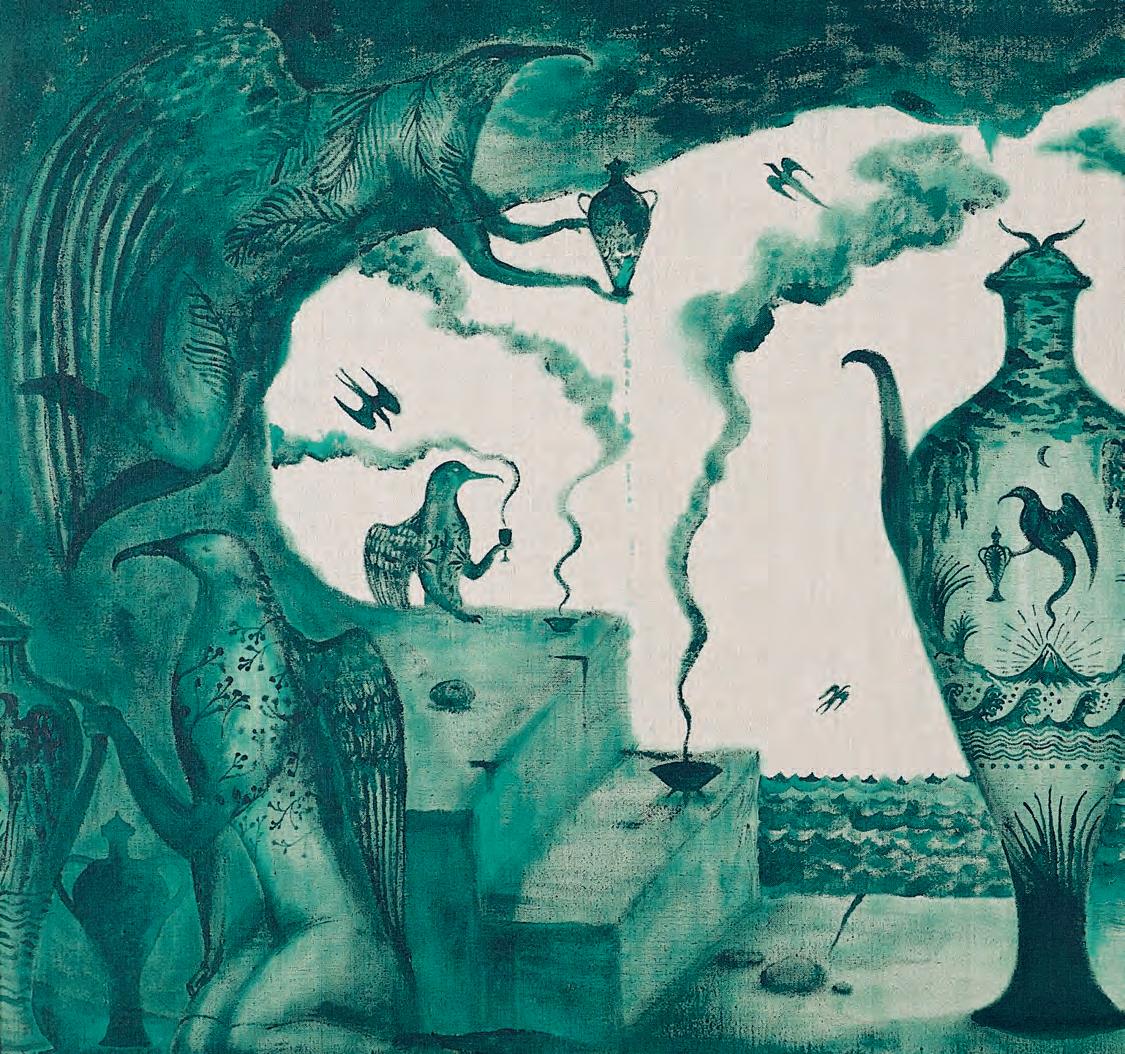


Printer




Printer
Paul Evans Managing Director paul@webbs.co.nz +64 21 866 000
Mel Hargrave General Manager mel@webbs.co.nz +64 27 929 5604
Karen Rigby Business Manager karen@webbs.co.nz +64 22 344 5610
Caolán McAleer Head of Marketing caolan@webbs.co.nz +64 27 929 5603
Elizabeth Boadicea Snow Marketing Manager elizabeth@webbs.co.nz +64 22 029 5611
Olivia Woodgate Creative Director design@webbs.co.nz +64 22 323 4919
Centurion Print
Edition of 1,700 Offset Printed, 72 pages
300gsm Matt Art 113gsm Matt Art
Freely distributed to subscribers or available at select public art spaces and hospitality venues.
Valuations
Tasha Jenkins Head of Art tasha@webbs.co.nz +64 22 595 5610
Mark Hutchins-Pond Senior Specialist, Art mark@webbs.co.nz +64 22 095 5610
Stephanie AuYeung Manager, Art stephanie@webbs.co.nz +64 22 301 8259
Georgina Brett Specialist, Art georgina@webbs.co.nz +64 27 929 5609
Sean Duxfield Specialist, Art sean@webbs.co.nz +64 210 536 504
Jo Bragg Inventory Coordinator, Art jo@webbs.co.nz +64 21 113 5001
Hannah Owen Registrar, Art hannah@webbs.co.nz +64 9 529 5609
Georgia Clapshaw Administrator, Art art@webbs.co.nz +64 9 529 5609
Charles Tongue Valuations Specialist valuations@webbs.co.nz +64 22 406 5514
33a Normanby Road Mount Eden Auckland, 1024
23 Marion Street Te Aro Wellington, 6011 webbs.co.nz
It is not unusual for Webb’s to present single-owner collections; however, a double-owner collection is a unique occasion. I was therefore intrigued when the vendors of this sale first approached me and, hearing about how they acquired these works, I realised that this auction was an opportunity not to miss. It is a pleasure to now bring All Shook Up: A Double Owner Collection to fruition.
The catalogue offers a selection of works from two separate yet connected collections. The works were amassed by two Wellington collectors who were part of an art group that ran from the mid-1990s until the mid-2000s, and after this point the works were distributed among the members. After the group disbanded our two collectors continued buying art separately and, because of their shared aesthetic tastes, the works that were acquired subsequently still have visual similarities — showing how the journey of a collector is heavily influenced by time and place.
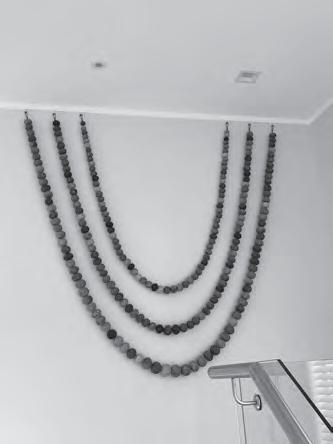
It is likely that this artistic offering would be very different had the works come from two Auckland- or Christchurch-based collectors. Many of the works were purchased from iconic Wellington dealers such as Peter McLeavey, Hamish McKay and Robert Heald. One vendor recalls first meeting McLeavey in the 1990s and how generous he was, encouraging him to really consider buying a Bill Hammond work, suggesting he live with it at home before committing to purchasing the painting. Because of the Wellington-centric roots of much of the collection, we are particularly looking forward to showcasing works from this special sale in our Te Aro gallery ahead of the auction.
The works presented within this selection are not necessarily from the most famous New Zealand artists – for example, there is no presence at all of Kiwi legend Colin McCahon – but rather focused on artists who were living and working over the 30 or so years
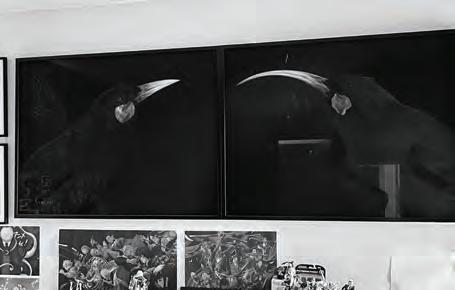
out Still Life with James Joyce, which forces the viewer to make connections between the repeating shapes and signs that can be installed in different ways each time they are displayed.
our vendors accumulated these artworks. Therefore, the collection features a well-rounded selection of contemporary women artists, including photographic works by Ans Westra, Lisa Reihana and Fiona Pardington and fantastic large-scale paintings by Christina Pataialii and Liz Maw, to name a few. Also included is a diverse range of contemporary Māori practitioners such as Reuben Paterson, Robin White, Darryn George, Shane Cotton, and Hiria Anderson-Mita.
When considering the collection as a whole, different trends begin to appear, and you can visibly trace different threads between the works. For me, visual themes that crop up again and again are repetition, pattern, and a layering of symbols and signs, often map-like in their execution. For example, Roger Mortimer’s Ngamahau, a literal depiction of a map, and the large-scale Killeen cut-
The work of Tony de Lautour, Shane Cotton, Séraphine Pick and Bill Hammond, who became synonymous with the Aotearoa art scene in the 1990s (when our collectors began their journey), also has strong map-like references — with icons and symbols dotted across sparse backgrounds. Séraphine Pick’s Did You Hear Something is a wonderful large-scale work from 1999 that sees delightful accents of peach amidst the artist’s signature scratchy forms. The myriad of Cotton works showcase the repeating symbols that he has used throughout his practice, often with the colour black as a base, which we also see in the work of peer de Lautour. Hammond has been a favourite for our two collectors, with a fantastic and almost telescopic range of his artworks present: from the 1980s Elvis-inspired loose canvas All Shook Up, featured in the iconic Christchurch Art Gallery Te Puna o Waiwhetū show Jingle Jangle Morning, to the beautifully soft Cornwall Road Cave from 2011, painted in teal on raw linen. Also included is a variety of prints, including the final series Hammond made in 2020, with a beautiful, singular gold dancing bird.
Some of the earliest works in the collection are by Richard Killeen and Gordon Walters, who both favour repeating abstracted patterns and shapes — seen here in Killeen’s toothy Green Tipped Comb and Walters’ signature koru forms. The koru crops up again in a more subtle way in the smooth Paul Dibble work, and again in Andrew McLeod’s carefully painted Abstraction. Robin White and Tamari Cabeikanacea’s Waiting for Vika emphasises different Indigenous patterning, that of Fiji, while Reuben Paterson’s Something is Going to Happen to Me Today takes a wallpaper-like expanse of tropical hibiscus and ‘flamingo flowers’ and elevates them to a glowing, glitter finish. Classic works by Darryn George and Simon Morris round out this pattern party.
Going back to layering and repetition of symbols, this is a visual device clearly seen in the work of Kushana Bush, whose figures are so densely layered they seem to stack on top of each other to the upper edge of the picture plane. Banks & Vahine / Tupaia’s Map is a beautiful, almost romantic, example of Lisa Reihana’s work, which builds up a constructed, almost hyper-real image of historic Aotearoa. Another such case is Fiona Pardington’s Andrew’s Huia Pair, showing the two birds facing one another, almost like reflections.
Within the collection there is a wonderful selection of sculptures by artists who utilise natural materials. One example is the curved forms of Tanya Ashken’s Luna which echo the natural materials of bronze and wood used by the artist. Multiple beautiful stone works are featured, including two stunning pieces Chris Charteris, and smaller works by John Edgar and Joe Sheehan. Fantastic bronzes by Aotearoa sculpture mainstays Paul Dibble and Terry Stringer round out this offering.
The Art team have worked hard to bring this excellent catalogue to life and we are delighted to now share it with you. A selection of the works will be on view in Wellington ahead of the full Auckland viewing and live auction, which will take place on Monday 15 July.
We hope you enjoy this special catalogue as much as we have enjoyed putting it together. Should you have any questions about the works featured or the auction, please do get in touch.

We invite you to join us at our Te Aro gallery for a discussion with Dr Chelsea Nichols, Senior Curator at Dowse Museum, who will share her personal highlights from this unique catalogue. Please RSVP to karen@webbs.co.nz.
Join us to hear AD Schierning, Director at Te Uru Waitākere Contemporary Gallery, share her thoughts on the fantastic works in the All Shook Up catalogue. Please RSVP to art@webbs.co.nz.
Auckland
Tasha Jenkins Head of Art tasha@webbs.co.nz
+64 22 595 5610
Georgina Brett Specialist, Art georgina@webbs.co.nz
+64 27 929 5609
Hannah Owen Registrar, Art registrar@webbs.co.nz
+64 9 529 5609
Wellington
Mark Hutchins-Pond Senior Specialist, Art mark@webbs.co.nz
+64 22 095 5610
Georgia Clapshaw Administrator, Art art@webbs.co.nz
+64 9 529 5609
Christchurch
Sean Duxfield Specialist, Art sean@webbs.co.nz +64 21 053 6504
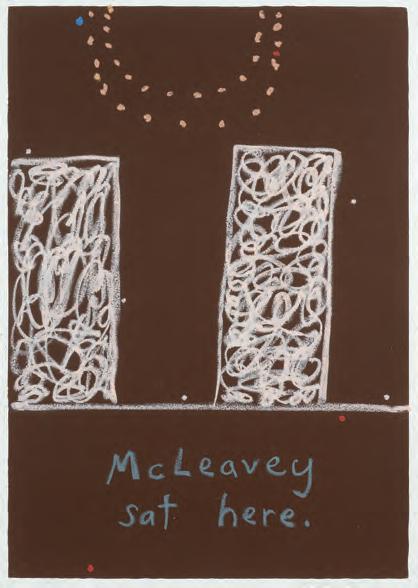
1 John Reynolds, McLeavey Sat Here #35 2011 oil pastel on screenprint on paper signed Reynolds, dated 2011 and inscribed '#35' in graphite lower edge 690 × 495mm
est $3,500 — $5,500
provenance
Private collection, Wellington.

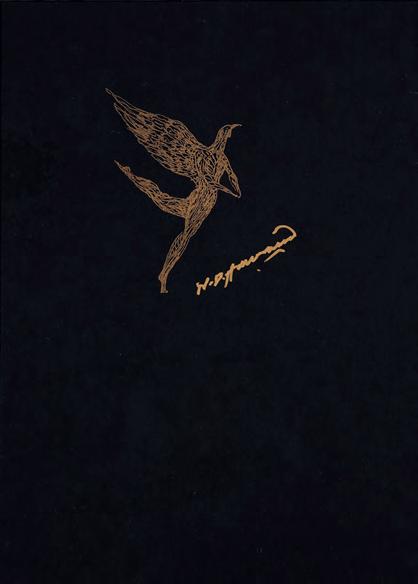
2 Bill Hammond, untitled 2020 screenprint on paper, edition of 50 signed W. D. Hammond in ink centre 280 × 205mm
est $5,000 — $8,000
provenance
Private collection, Wellington. Acquired from McLeavey Gallery, Wellington.
literature
Peter Vangioni with Tony de Lautour, Rachael King, Nic Low, Paul Scofield and Ariana Tikao; Bill Hammond: Across the Evening Sky, (Christchurch: Christchurch Art Gallery Te Puna o Waiwhetū, 2021), frontispiece.
3 Liz Maw, Young David Attenborough 2007
giclée print on paper, edition of 10 615 × 418mm
est $1,500 — $3,000
provenance
Private collection, Wellington. Acquired from Ivan Anthony Gallery, Auckland.
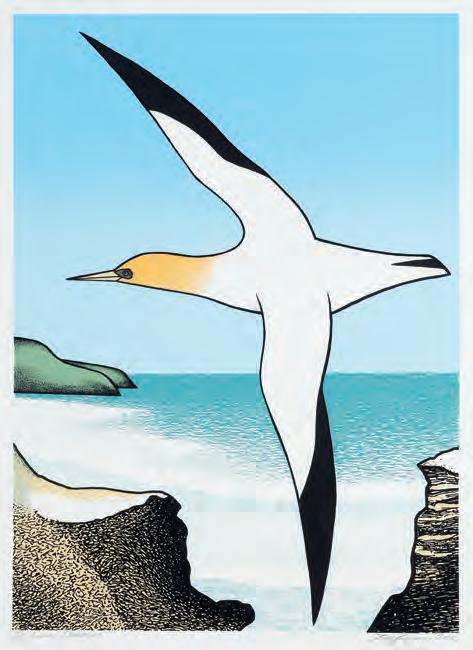
4 Don Binney, Manunui, Otakamiro 2010
screenprint on paper, 28/80 signed Don Binney, dated 2010 and inscribed 28/80 Manunui, Otakamiro in graphite lower edge 480 × 345mm
est $18,000 — $26,000
provenance
Private collection, Wellington. Acquired from The Diversion Gallery, Picton, 2011.
literature
Another from the edition featured in Gregory O'Brien, Don Binney: Flight Path (Auckland: Auckland University Press, 2023), 335.

5 Bill Hammond, untitled 2006
lithograph on paper, edition of 100 signed Bill Hammond and dated 2006 in graphite lower right 585 × 430mm
est $8,500 — $14,000
provenance
Private collection, Wellington. Acquired from McCahon House Trust, Auckland.

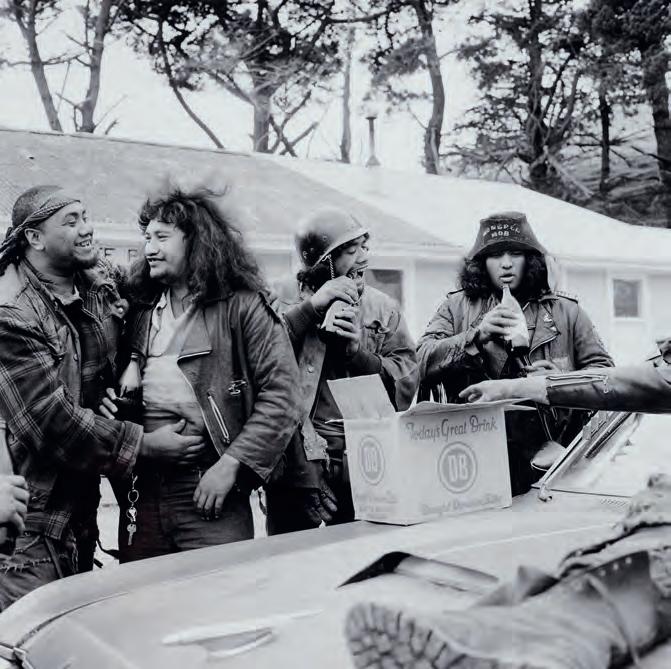
6 Ans Westra, Rātana Church, Raetihi 2005. printed 2022. archival pigment print on Hahnemühle paper, 23/25 380 × 380mm
est $3,500 — $5,500
provenance
Private collection, Wellington. Acquired from Suite Gallery, Wellington.
7 Ans Westra, Mongrel Mob Convention, Porirua 1982. printed 2023. archival pigment print on Hahnemühle paper, 23/25 380 × 380mm
est $3,000 — $5,000
provenance
Private collection, Wellington. Acquired from Suite Gallery, Wellington.
8 Ans Westra, Penny Divers, Whakarewarewa, Rotorua 1963. printed 2023. archival pigment print on Hahnemühle paper, 12/25
380 × 380mm
est $3,500 — $5,500
provenance
Private collection, Wellington. Acquired from Suite Gallery, Wellington.
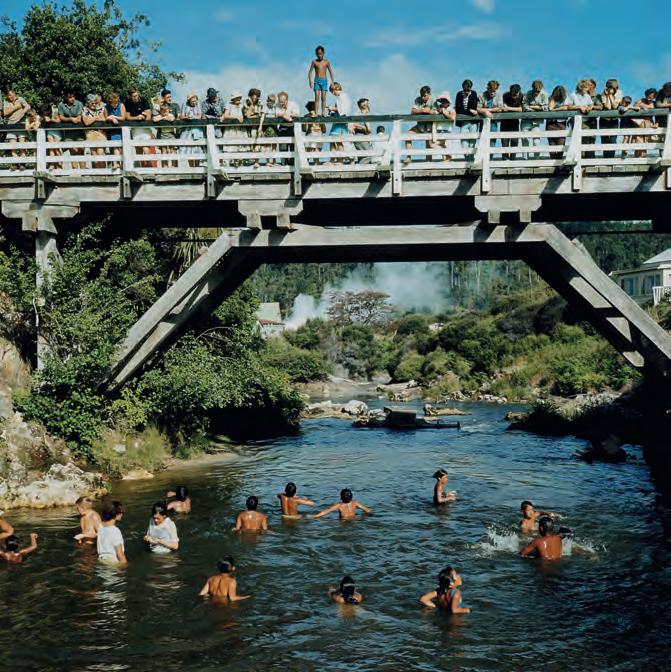
9 Ans Westra, Two Wahine, Whakarewarewa, Rotorua 1963. printed 2022. archival pigment print on Hahnemühle paper, 21/25
380 × 380mm
est $3,500 — $5,500
provenance

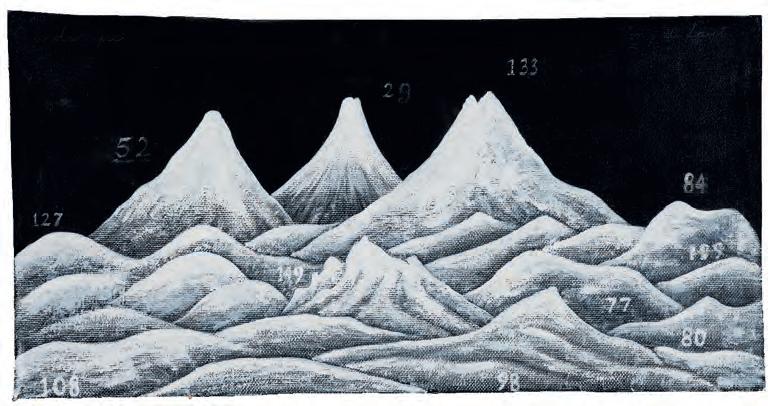
10 Tony de Lautour, Landscape 2 2002 oil on canvas
signed Tony de Lautour in brushpoint upper right; inscribed Landscape in brushpoint upper left 185 × 370mm
est $3,000 — $5,000
provenance
Private collection, Wellington. Acquired from
11 Tony de Lautour, Monument Plan 2002 oil on canvas
signed TdL and dated 2002 in brushpoint upper right; inscribed Monument Plan in brushpoint upper left 500 × 300mm
est $4,500 — $7,500
provenance
Private collection, Wellington. Acquired from Hamish
Gallery, Wellington, 2005.
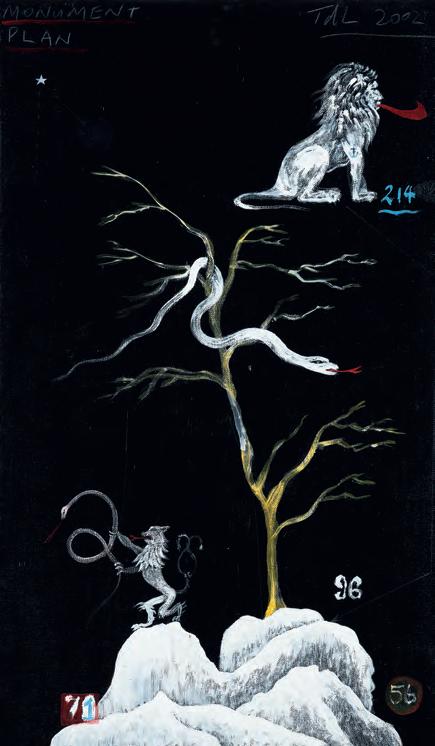
12 Shane Cotton, Half Cast 2010
acr ylic on screenprint on paper signed Shane W Cotton, dated 2010 and inscribed HALF CAST in brushpoint lower right 1210 × 1210mm
est $8,000 — $14,000
provenance
Private collection, Wellington. Acquired from Hamish McKay Gallery, Wellington.
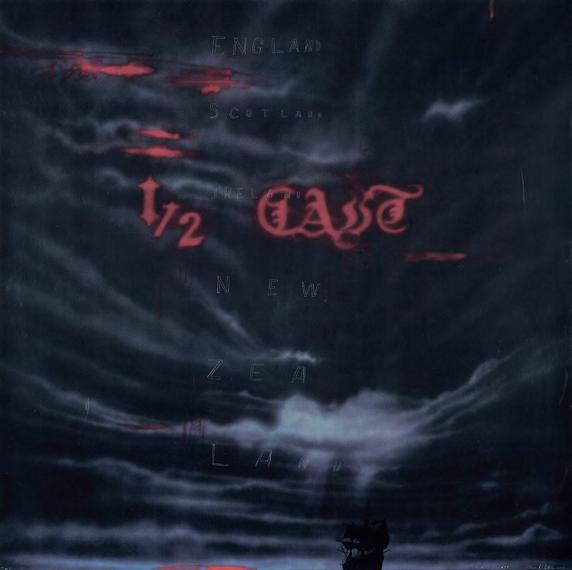
13 Shane Cotton, Stelliferous Biblia 23 2002
oil on canvas signed S. Cotton, dated 2002 and inscribed Stelliferous Biblia 23 in ink verso 350 × 350mm
est $10,000 — $15,000
provenance
Private collection,

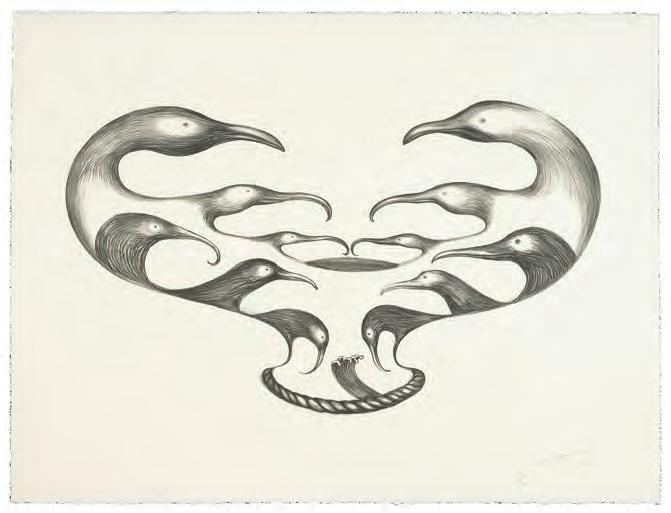
14 Bill Hammond, untitled 2000
lithograph on paper, 23/30 signed WD Hammond and dated 2000 in graphite lower right
560 × 745mm
est $6,000 — $10,000
provenance
Private collection, Wellington.
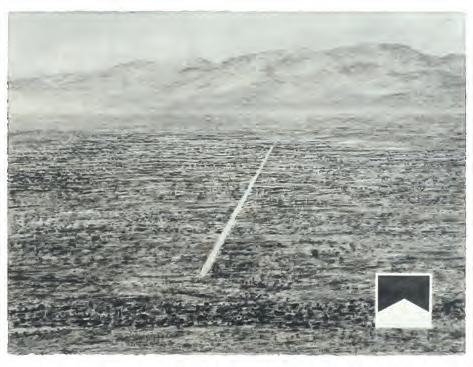
15 Michael Stevenson, Isolated Mass 1993 charcoal on paper
560 × 750mm
est $3,000 — $5,000
provenance

16 Shane Cotton, Blue/Black V 2007 acr ylic on paper signed S. COTTON, dated 2007 and inscribed BLUE/BLACK V in ink lower edge
580 × 760mm
est $4,000 — $8,000
provenance
17 Richard Killeen, untitled 1977
oil, enamel and sand on paper signed Killeen and dated October 77 in graphite lower right 305 × 305mm
est $4,000 — $6,000
provenance
Private collection, Wellington. Acquired from Brett McDowell Gallery, Dunedin.
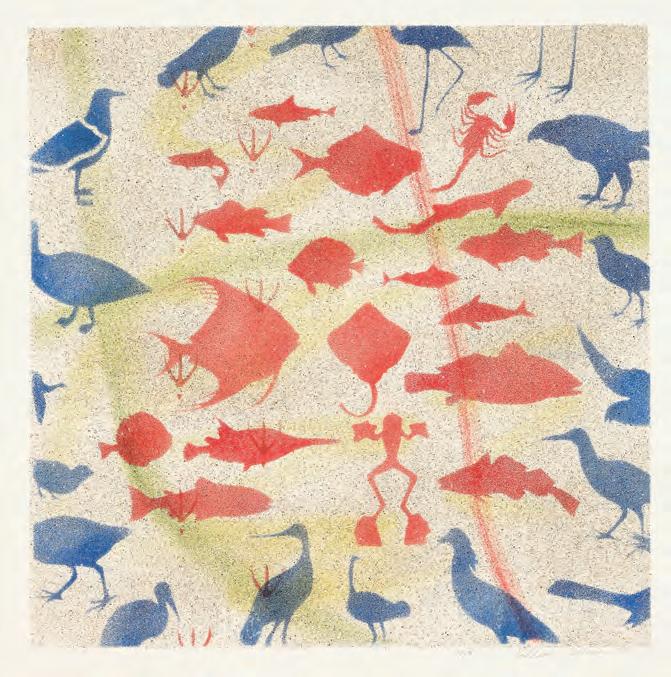
18 Richard Killeen, Untitled 1977 oil and enamel on aluminium signed Killeen and dated 1977 in ink verso 580 × 580mm
est $15,000 — $25,000
provenance
Private collection, Wellington. Acquired from McLeavey Gallery, Wellington.
literature
Francis Pound, Stories we tell ourselves: The Paintings of Richard Killeen (Auckland: Auckland Art Gallery Toi o Tāmaki, 1999), 68.
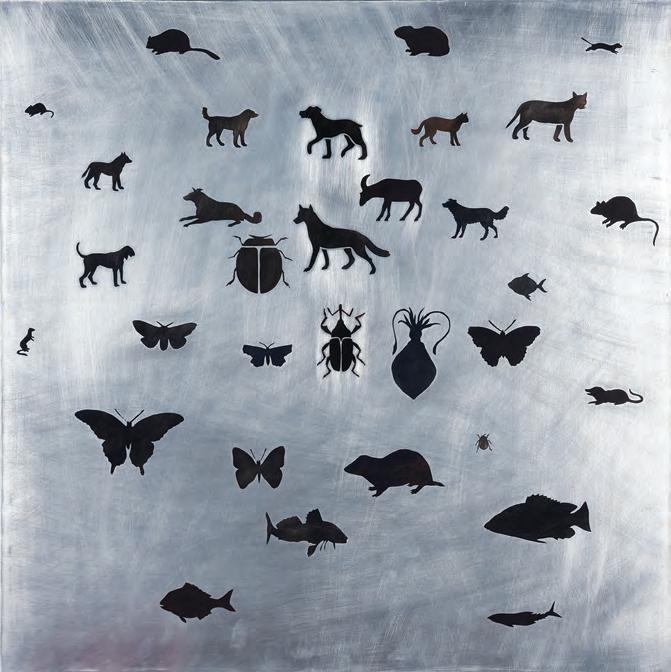
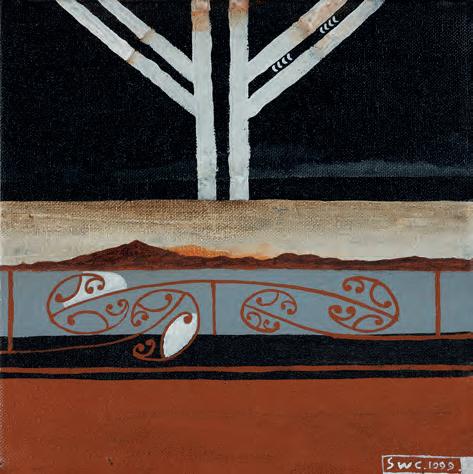
19 Shane Cotton, untitled 1999 oil on canvas
signed SWC and dated 1999 in brushpoint lower right
200 × 200mm
est $8,000 — $12,000 provenance
Private collection, Wellington. Acquired from Mori Gallery, Sydney, c2000.

21 Shane Cotton, untitled 1999 oil on canvas
signed S Cotton and dated 1999 in brushpoint lower right
200 × 200mm
est $8,000 — $12,000 provenance
Private

20 Shane Cotton, untitled 1999 oil on canvas
signed SWC and dated 1999 in brushpoint lower right
200 × 200mm
est $8,000 — $12,000 provenance
Private collection, Wellington. Acquired from Mori Gallery, Sydney, c2000.
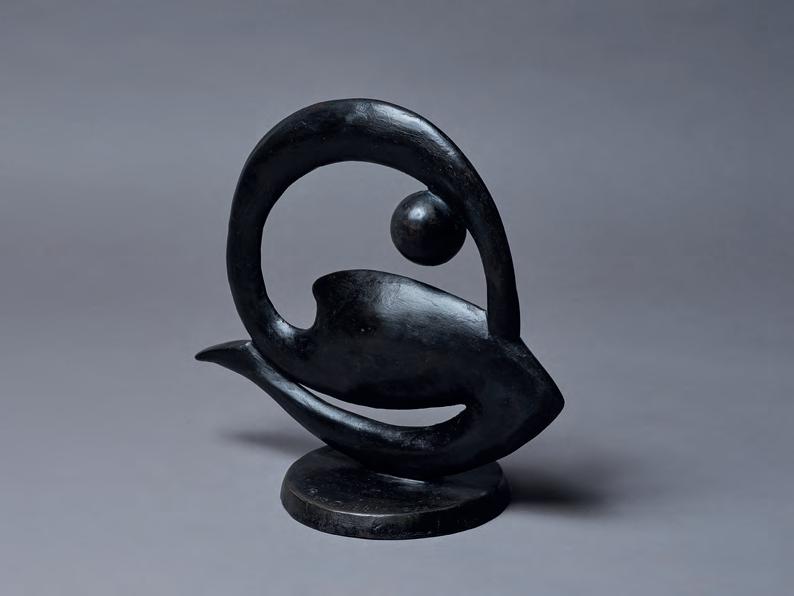
22 Paul Dibble, Soft Geometric, Smaller Curled Figure Study 2
2012 bronze, 2/2
signed Paul Dibble and inscribed 2/2 with incision on base
310 × 350 × 155mm (widest points)
est $16,000 — $19,000
provenance
Private collection, Wellington. Acquired from Zimmerman Gallery, Palmerston North.
23 Andrew McLeod, Abstraction 2000 oil on canvas
485 × 365mm
est $8,000 — $12,000
provenance
Private collection, Wellington. Acquired from McLeavey Gallery, Wellington, c2000.
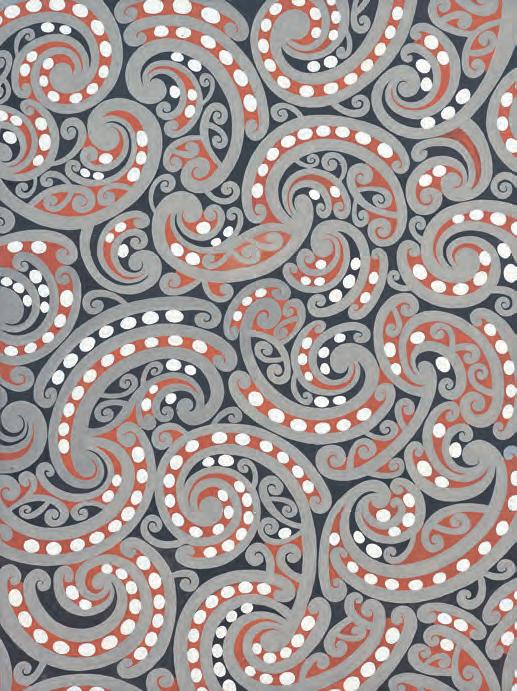
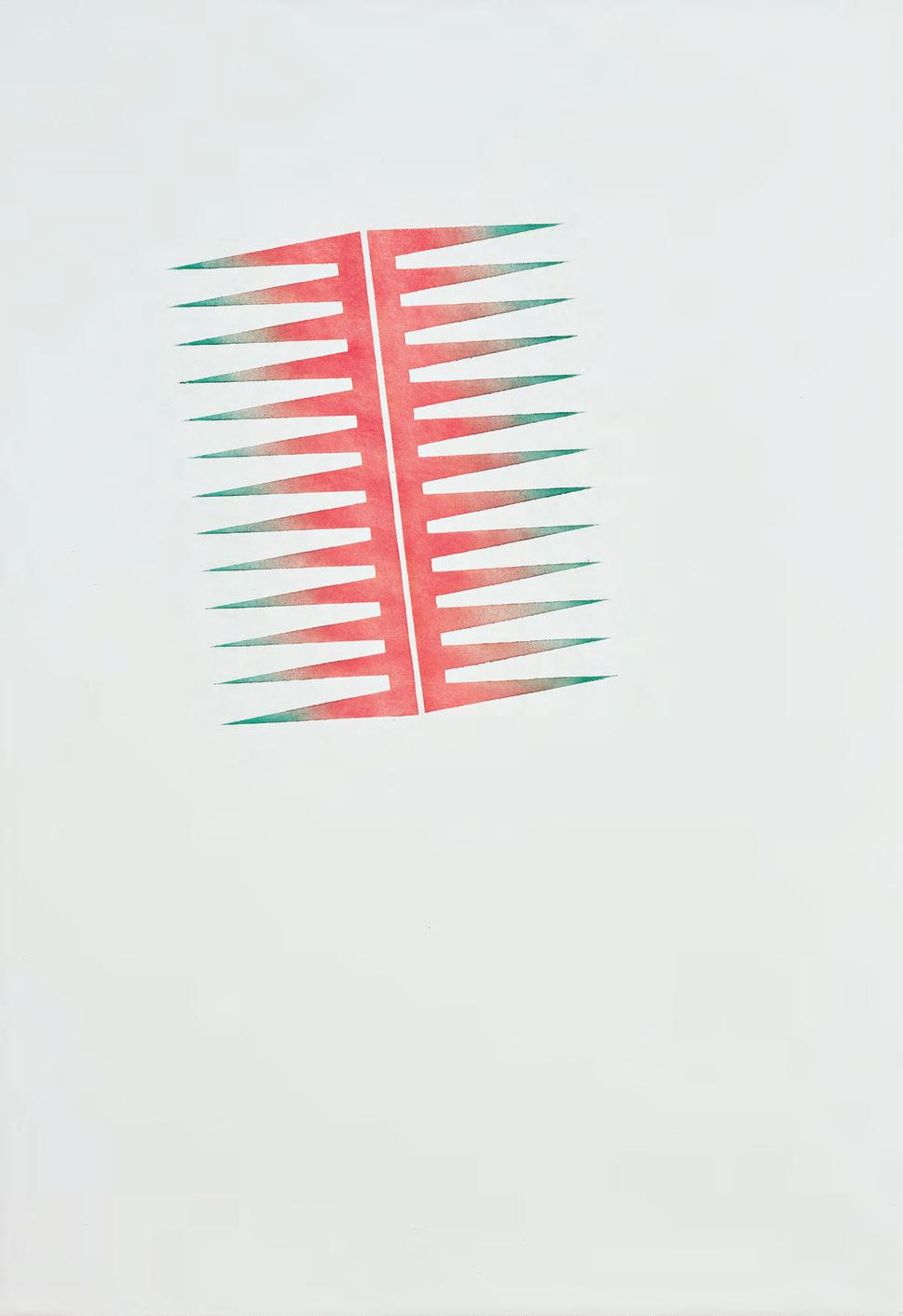
24 Richard Killeen, Green Tipped Comb 1974 oil and acr ylic on canvas signed Killeen and dated 74 in ink verso
660 × 455mm
est $15,000 — $25,000
provenance
Private collection, Wellington. Acquired from McLeavey Gallery, Wellington.
25 Gordon Walters, Kapiti 1984
screenprint on paper, 69/75 signed Gordon Walters, dated 84 and inscribed Kapiti 69/75 in graphite lower edge
500 × 380mm
est $15,000 — $25,000
provenance
Private collection, Wellington. Acquired from Starkwhite Gallery, Auckland.
26 Gordon Walters, Arahura 1982
screenprint on paper, artist's proof signed Gordon Walters, dated 1982 and inscribed 'Arahura' Artist's proof in graphite lower edge
750 × 555mm
est $15,000 — $25,000
provenance
Private collection, Wellington. Acquired from Starkwhite Gallery, Auckland.



27 Kushana Bush, The Bending Hours 2016
gouache and graphite on paper
675 × 375mm
est $12,000 — $16,000
provenance
Private collection, Wellington. Acquired from Brett McDowell Gallery, Dunedin, 2016.
exhibitions
Kushana Bush: The Burning Hours, Dunedin Public Art Gallery, 3 December 2016–17 April 2017.
literature
Kushana Bush; The Burning Hours (Dunedin: Dunedin Public Art Gallery, 2016), 114–115.
28 Robin White and Tamari Cabeikanacea, Waiting for Vika 2019
earth pigments and natural dye on barkcloth
1040 × 640mm
est $14,000 — $24,000
provenance
Private collection, Wellington. Acquired from Two Rooms, Auckland, 2019.
exhibitions Robin White with Tamari Cabeikanacea: That Vase, Two Rooms, Auckland, 24 July–29 August 2020.
literature Sarah Farrar, Jill Trevelyan and Nina Tonga; Robin White: Something is Happening Here (Wellington: Te Papa Press and Auckland: Auckland Art Gallery Toi o Tāmaki, 2022), 249.
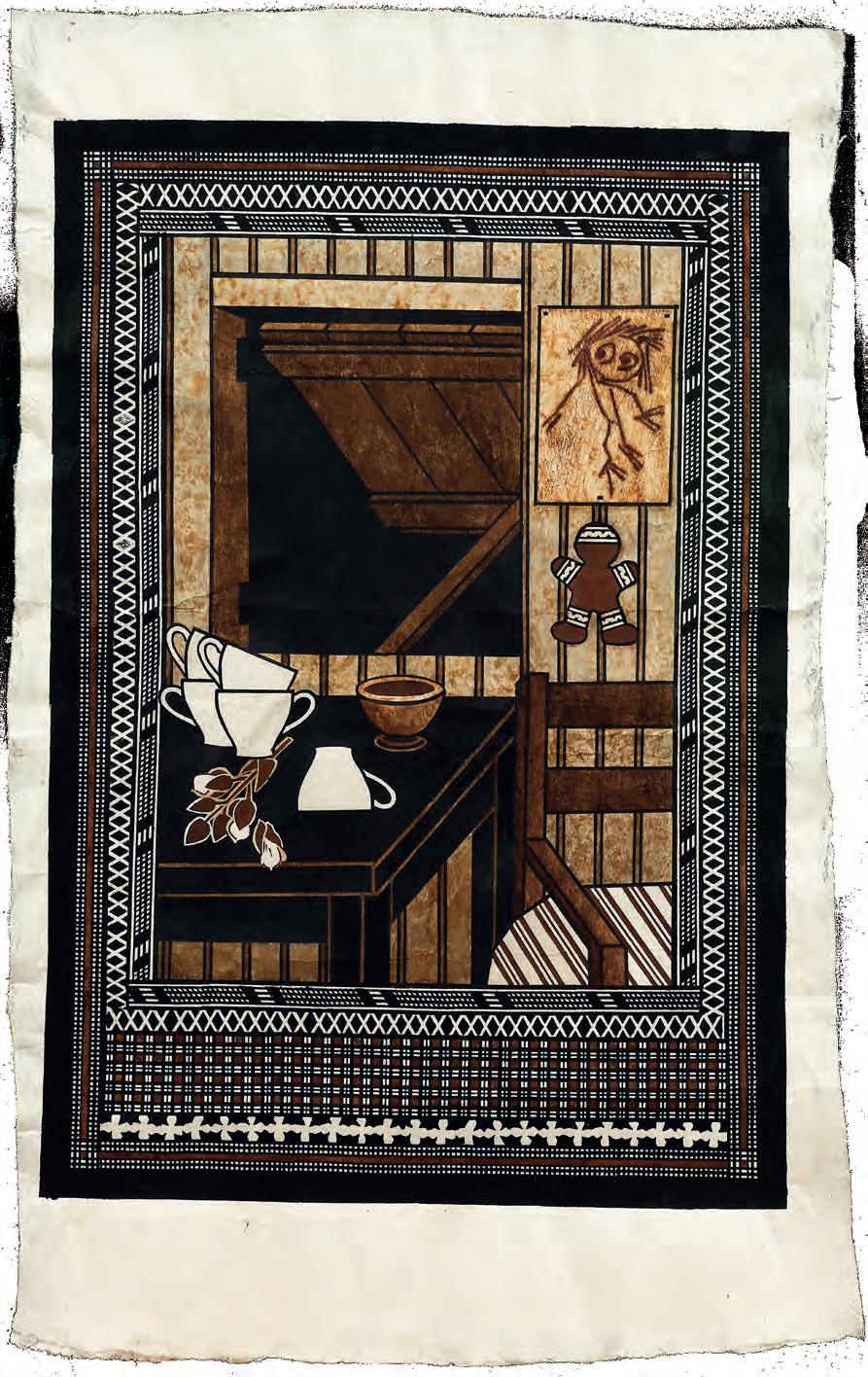

29 Chris Charteris, Unlocked 2009
Coromandel andesite; wood and metal base
signed CC and dated 09 with incision on base
235 × 1200 × 140mm (widest points)
est $8,500 — $12,500
provenance
Private collection, Wellington.
exhibitions
Chris Charteris: Unlocked, Koru Contemporary Art, Hong Kong, 4 September - 30 October 2009.
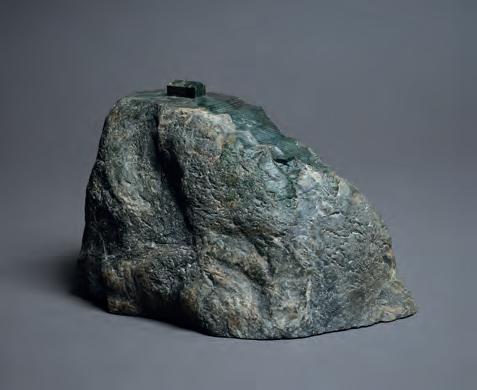
30 Joe Sheehan, Nirvana 16 2018
Taranaki argillite
signed JS and dated '18 with incision on base
180 × 260 × 160mm (widest points)
est $6,000 — $12,000
provenance
Private collection, Wellington. Acquired from Tim Melville Gallery, Auckland, 2018.
exhibitions
Tim Melville Gallery, Auckland Art Fair, Auckland, 23–27 May 2018.
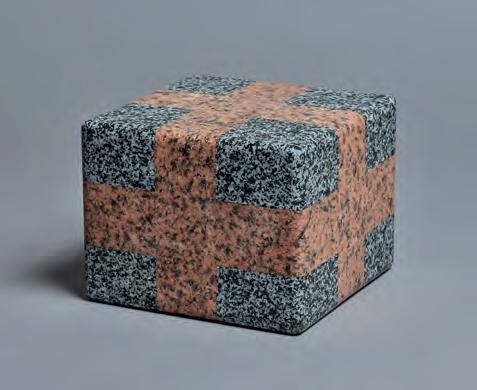
31 John Edgar, Cube 12 granite and serpentine 185 × 180 × 140mm
est $4,500 — $9,500
provenance
Private collection, Wellington.
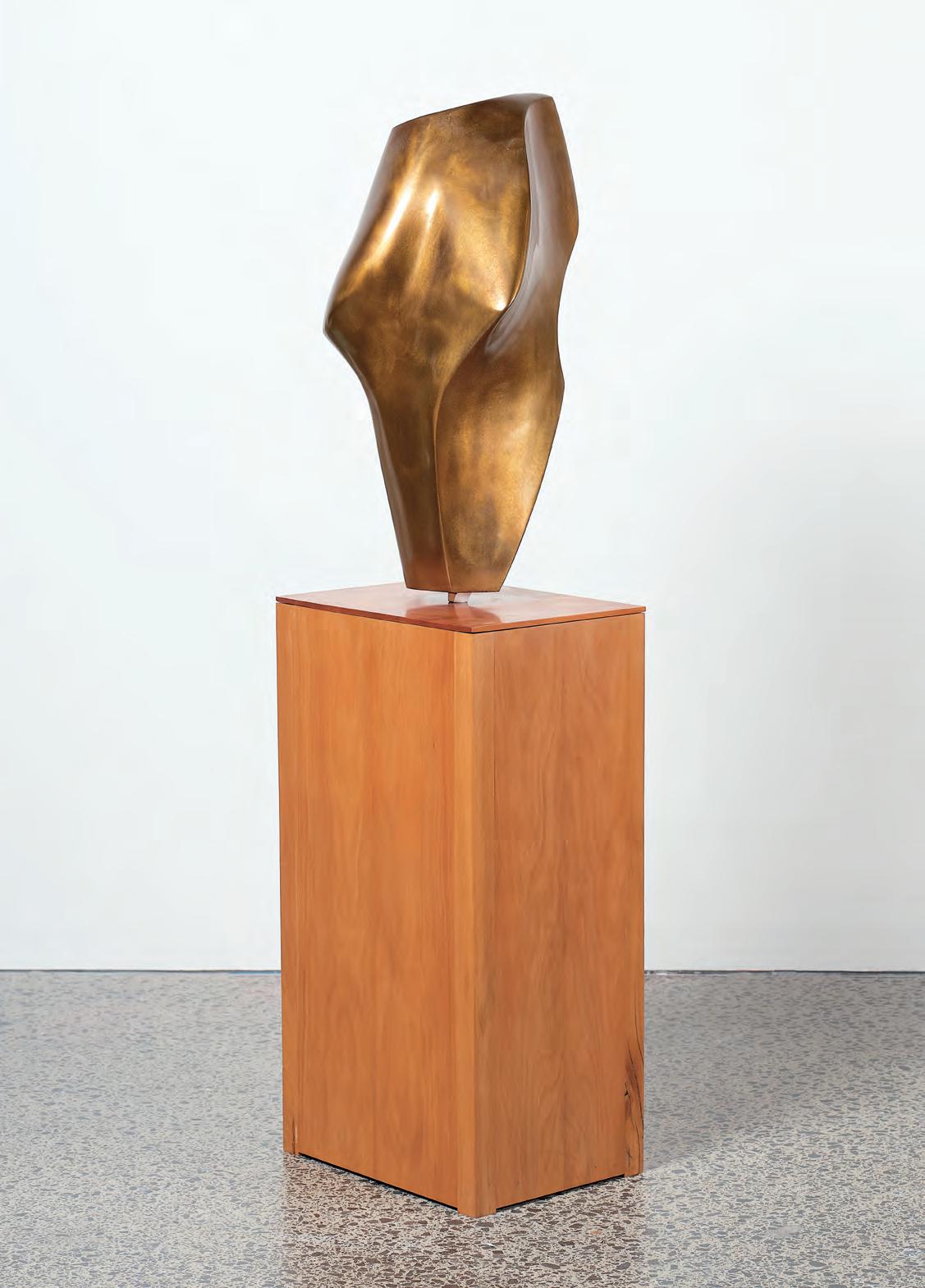
32 Tanya Ashken, Luna 2019
bronze and wood, 2/9 1410 × 400 × 300mm (widest points) est $16,000 — $25,000
provenance
Private collection, Wellington. Acquired from Fe29 Gallery, Dunedin.
exhibitions
Another from the edition exhibited in Tanya Ashken: From the Subconscious, Fe29 Gallery, Dunedin, 2 December 2023–15 January 2024; Tanya Ashken — Selected Bronzes, Hamish McKay Gallery, Wellington, 13–27 November 2021.
The birds of Fiona Pardington’s photographic practice do not flit nervously, or chirp sweetly. At their larger-than-life scale, emerging from the inky void behind them, these avian subjects peer out at the viewer and exude mana.
Pardington (Ngāi Tahu, Kāti Māmoe, Ngāti Kahungunu, Clan Cameron of Erracht) is undoubtedly one of Aotearoa’s most esteemed photographers, frequently turning her lens to vanitas and still life, with a strong foothold in te ao Māori and the natural world. The continual pursuit of her craft is evident, too, in her commitment to higher education and research, achieving her bachelor’s degree in 1984, then a master’s in 2003, before culminating in a 2013 doctorate from Elam School of Fine Arts.
Kaka Nestor Meridionalis, Canterbury Museum presents to us the native kākā, with its distinct olive-grey plumage and russet chest. Under her lens, Pardington’s subject sheds the static afterlife of museum artefact and returns to us, lifelike. Here, our subject assumes the hero’s pose: standing to attention in the foreground, the curve of its neck leading the viewer’s eye to that of the bird itself. Pardington lights the frame just so, the kākā’s eye shrouded just enough to conceal the intent of its gaze. This bird – with all that it has witnessed of human history in Aotearoa – what does it make of us? Is its gaze imperious or protective, foreboding or benevolent?
Similarly, in regarding these two longextinct huia, one recognises instantly that the subjects of Andrew’s Huia Pair must be taxidermied specimens, too. After all, the last known sighting of a live huia – so prized by Māori (and later, Pākehā alike) for their white-tipped feathers and the mana subsequently bestowed upon the wearer – was 1907. Unfortunately, it was a combination of this human pursuit and deforestation in a rapidly expanding colonial New Zealand that contributed to the huia’s extinction. With the short-billed male on the left, and the iconic, curved-beaked female on the right, this diptych echoes the marriage portraits of human nobility, giving honour to the life and likeness of a species that no longer flies across Aotearoa’s open skies. The artist perhaps spoke most aptly when she proffered that “photography is very much a place of mourning for the things that are valuable in life,”1 and in Pardington’s images, we certainly find beautiful, haunting memoriam.
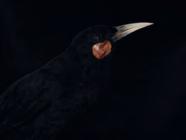

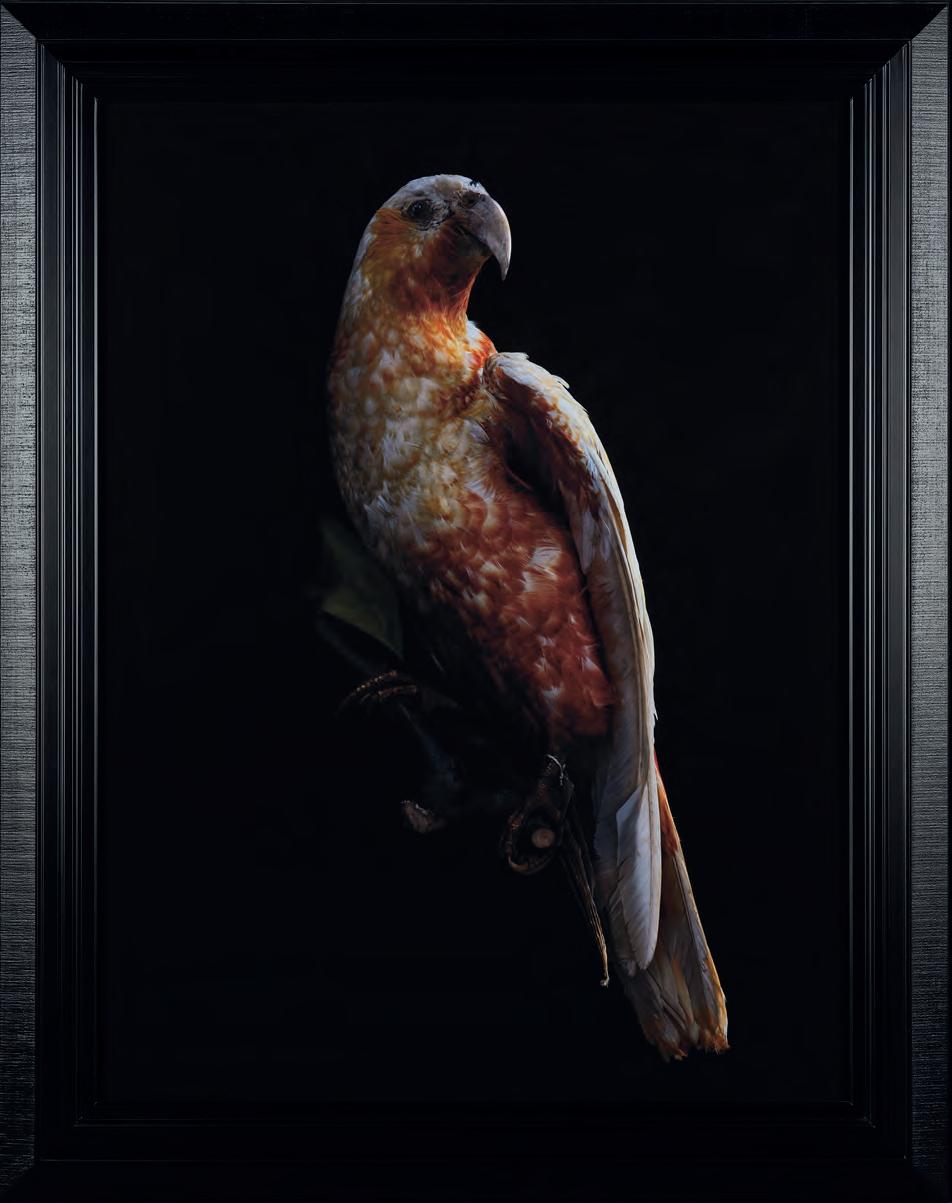
1450
est $25,000 — $35,000


34 Séraphine Pick, Camper 2000 oil on canvas signed Séraphine Pick and dated 2000 in brushpoint lower right 750 × 495mm
est $15,000 — $25,000
provenance
Private collection, Wellington.
35 Roger Mortimer, Ngamahau 2023
watercolour, gold dust, graphite and acrylic lacquer on canvas signed R Mortimer, dated 2023 and inscribed NGAMAHAU in graphite verso 800 × 700mm
est $6,000 — $12,000
provenance
Private collection, Wellington.
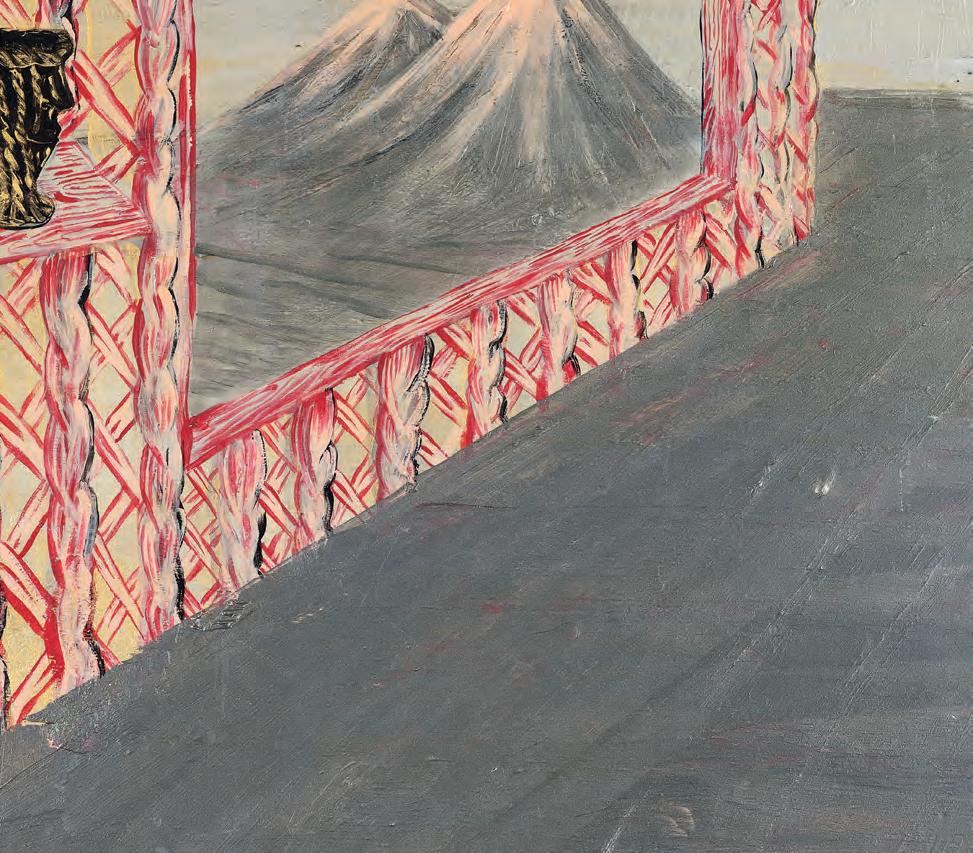
36 Bill Hammond, untitled 1985 oil on board signed W. Hammond and dated 1985 in brushpoint lower right 355 × 400mm est $20,000 — $30,000 provenance
Private collection, Wellington.
Under William Dunning’s painterly hand, history is made material, ossified into a carved-stone side table, laden with pictures-within-pictures and layered in meaning. Dunning’s practice has long interrogated the complexity of our colonial history in Aotearoa and, in doing so, has never shied away from that sense of discomfort. Dunning takes clever licence in his titling of the work, Colonial Timetable 1850–1900, a visual pun that has us leaning in closer to inspect this curious piece of furniture. Four male faces appear carved into the façade, their eyes cast outwards to disparate corners beyond our view and positioned not in unity, but fractured –quite literally – by a web of cracks that riddle the table’s surface from every angle. What should be something solid, stoic, of architectural integrity, instead stands splintered and unsteady, threatening to fall apart.
Sandwiched between these carved faces is a tableau of richly coloured vignettes lining the table’s frontage. Their curved arches present like portals, offering us glimpses into a colonial past that demands our attention, no matter how confronting. The painted figures, both Māori and Pākehā, stand frozen in time and though their stillness appears at first serene, closer inspection reveals their unsettledness: a downcast grimace, a furrowed brow, things not quite right.
The second half of the nineteenth century, which Dunning refers to, was a period of massive change and upheaval. Following the signing of Te Tiriti in 1840, the discrepancies between the English and te reo Māori translations would come to light, and with them the ripple effects dominoing forward into our present day. As much as Colonial Timetable memorialises the nuanced histories of our past, so too does it provide timely remembrance as we step forth into our future.
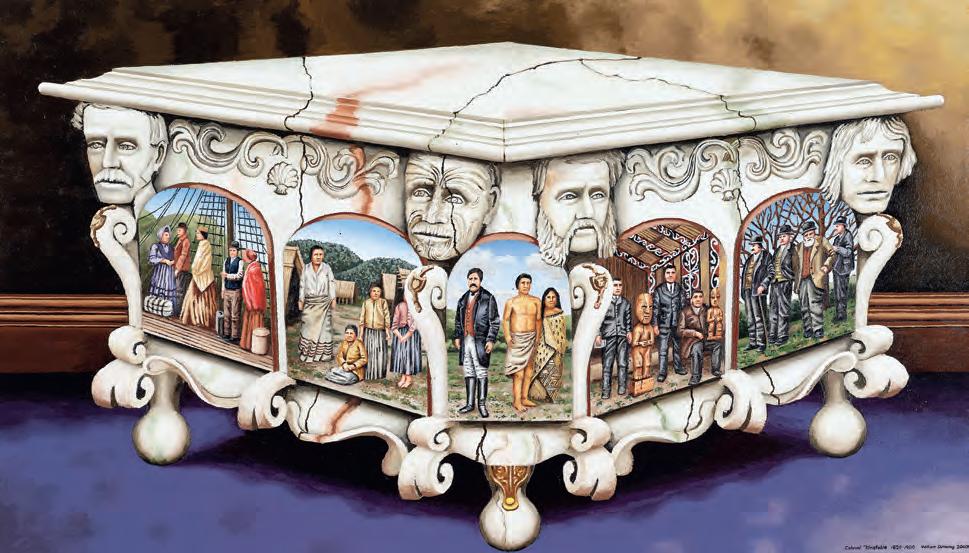
37 William Dunning, Colonial Timetable 1850-1900 2000 oil
signed William Dunning, dated 2000 and inscribed Colonial Timetable 1850–1900 in brushpoint lower right 800 × 1400mm
est $28,000 — $35,000
provenance
Private collection, Wellington. Acquired from McLeavey Gallery, Wellington, 2000.
When Lisa Reihana (Ngāpuhi, Ngāti Hine, Ngāi Tū) first exhibited In Pursuit of Venus [infected] at Auckland Art Gallery Toi o Tāmaki in 2015, visitors would sit in the darkened gallery for hours. Although the video was only 32 minutes long, its monumental scale and scrolling form meant there was always more to see: it was impossible to take it all in at once.
This print, taken from the extended version of In Pursuit of Venus [infected] made for Reihana’s exhibition Emissaries at the 2017 Venice Biennale, shows just two frames plucked from a vast panoramic video, 24 metres wide, four metres high and 64 minutes long. Held still, these scenes can be viewed slowly; we can consider the frozen gestures and complexity of relationships that we rarely see outside a colonial perspective. In this particular print, we see Joseph Banks – the English botanist who travelled with Cook – on the left, clad in a flamboyant striped robe, lustfully watching a beautiful vahine as she finger-brushes her hair. On the right, Tupaia – the Tahitian tohunga and navigator who accompanied Cook and Banks on forays to Aotearoa and Australia –draped in bright, sun-bleached white tapa sits on the ground, in conversation with a kuia clothed in what appears to be a kahu huruhuru (feather cloak), a huia feather adorning her hair.

pigment print on paper on aluminium dibond, edition of 9 755 × 1520mm
est $25,000 — $35,000
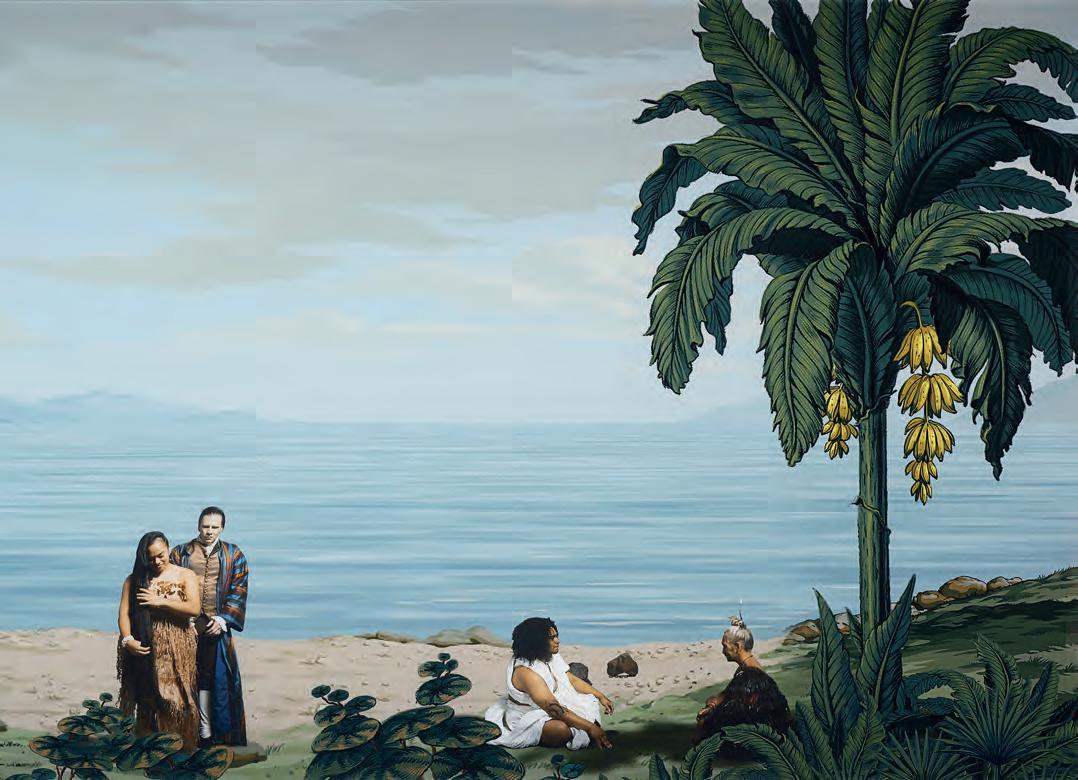
Writing about In Pursuit of Venus [infected] for the book accompanying Emissaries, Rhana Devenport describes how the work visualises Tā-Vā, a Pacific theory of time and space that, as theorist ‘Ōkusitino Māhina explains, “suggests the material world is perpetually under transformation by Tā (time and action) and Vā (space and content).”1 Holding time still, this print emphasises the relationship between Reihana’s work and the original wallpaper she drew inspiration from, Les Sauvages de la Mer Pacifique (1804–05), reminding us that everything, over time and through history, is in an eternal state of flux.
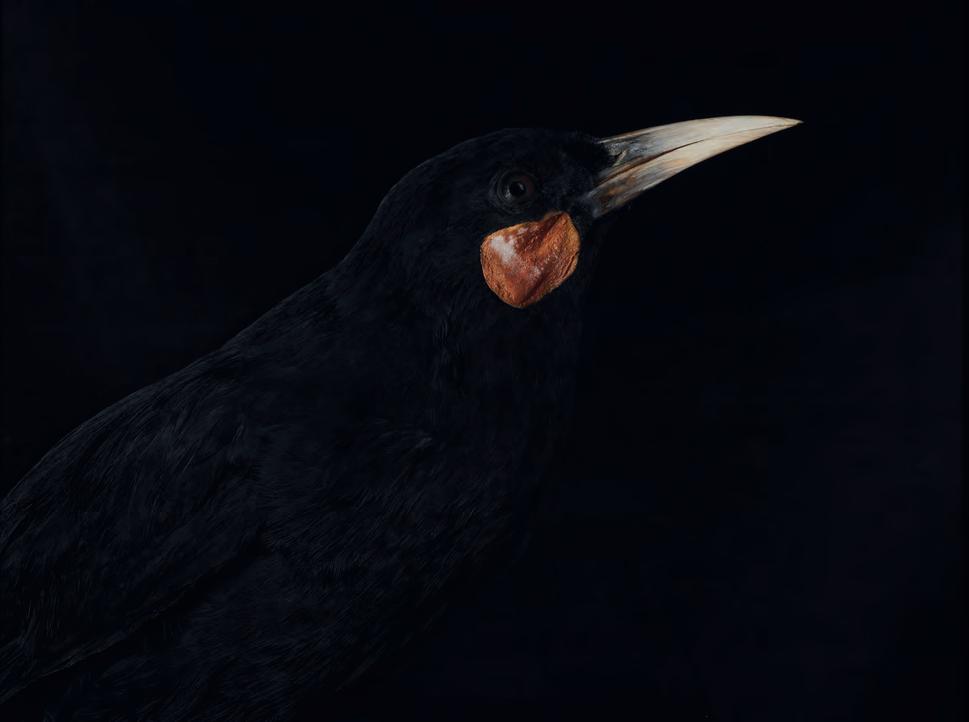

“Those who say there’s no mileage left in landscape had better meditate before these works and ponder the wisdom of their ways. In a sense, though, Woollaston isn’t painting landscapes … it’s as though he’s painting the energy inherent in what used to be called ‘creation’ – the turbulence and vitality of it, as well as its massive calm.”1
Toss Woollaston’s paintings energetically depict landscape environments, often places he lived in the South Island. His paintwork is distinctively gestural, featuring expressive brushwork and thick layers of paint. He is widely considered to be one of the key pioneers of New Zealand modernist painting, and indeed, esteemed art dealer Peter McLeavey engaged with the artist prior to entering the art business. These early interactions with Woollaston were formative for both men, and McLeavey initially built his art dealership on the work of Woollaston, Colin McCahon and Don Binney.
Taramakau is an exemplar of Woollaston’s practice, featuring his characteristic expressive painting style. The painting is titled after the Taramakau River on the west coast of the South Island — a subject that the artist painted
many times. The river meets the sea near to Greymouth, a town Woollaston long called home, and locations from that region feature prominently in his career output. This painting features a gestural application of lush oil paint, which the artist has worked with palpable vigour. In areas, the paint has been scraped and scumbled, adding to the sense of energy and movement in the work. The blue, grey and white at the top of the picture plane create an impression of a precipitous sky, while the yellows and oranges create an impression of a valley beneath purplish mountains, with a white and blue river flowing through it. This suggestion of landscape just holds together, almost breaking down into expressive abstraction, a recurrent theme within the artist’s work.

40 Toss Woollaston, Taramakau c1960s oil on board signed Woollaston in brushpoint lower right 522 × 900mm est $45,000 — $60,000
provenance
Private collection, Wellington.
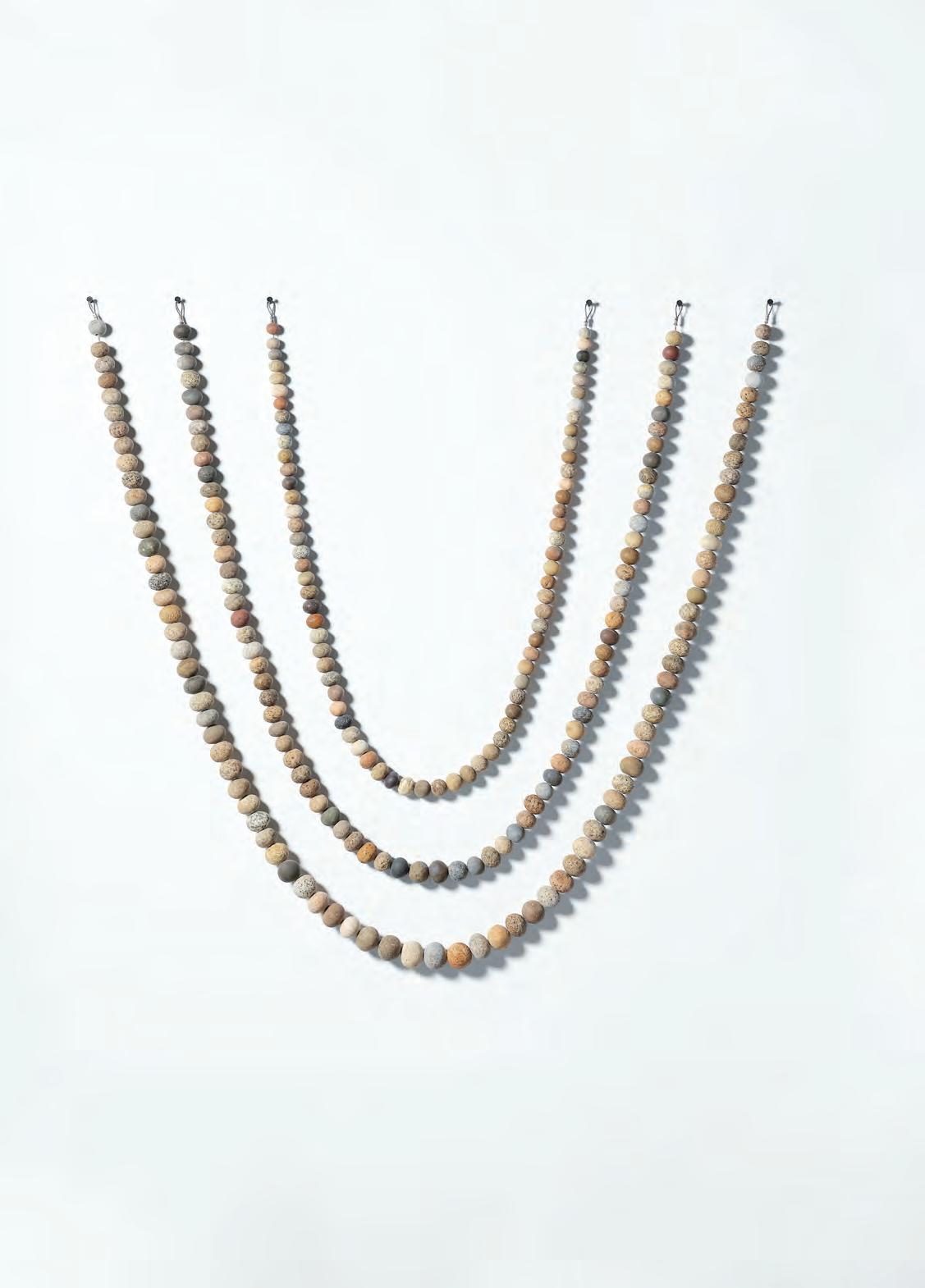
1500 × 1500mm (widest points) est $40,000 — $55,000
Private collection, Wellington.
▲ 1 “Chris Charteris,” Auckland Art Gallery Toi o Tāmaki, accessed 14 June 2024, https:// www.aucklandartgallery.com/explore-artand-ideas/artist/10145/chris-charteris
▲ 2 Philip Clarke, “Chris Charteris: Kotahitanga, 5 April – 4 May 2024,” FHE Galleries, https://www. fhegalleries.com/exhibition-2024chris-charteris-kotahitanga.html
There is something intrinsically satisfying about a good rock. Each person has their own metric for what makes a rock good in their eyes, but most will agree on the importance of texture, colour, shape and heft.
As a self-described “beach-comber-cumprofessional-scavenger,” sculptor and jeweller Chris Charteris (i-Kiribati, Fijian, English) has an eye for a good rock.1 Originally trained in Māori design and carving, Charteris moved from carving wood and bone to working with stone in the 1990s, drawn to the endless varieties and colours. Coastal Rhythm (2009) is one of many rock ‘necklaces’ he has made over the years, each one born from a process that involves finding, collecting and grading, before drilling a hole in each carefully chosen rock and stringing them like giant beads, each one perfectly shaped by nature over thousands of years.
In an essay accompanying Kotahitanga, Charteris’ 2024 exhibition at FHE Galleries, Philip Clarke traces the connection between his sculptural works – such as the stone necklaces – and jewellery, describing the way works like Coastal Rhythm can be seen as adorning architecture in much the same way as necklaces, bracelets and brooches adorn our bodies. “I know that the architecture of a wharenui, or meeting house, relates to the human body,” Clarke writes, “… if you apply a body-related concept of architecture to other sorts of buildings it’s quite natural, rather than outlandish, to festoon architectural space in a way that is similar to how we adorn ourselves.”2
There is something poetic about adorning our built environment with artworks made from natural rock, as though pointing to the evolution of the material, from smooth, beautiful river stones to moulded slabs of concrete, asking – as artists working with stone have done since time immemorial – not which came first, but which will still be here at the end.
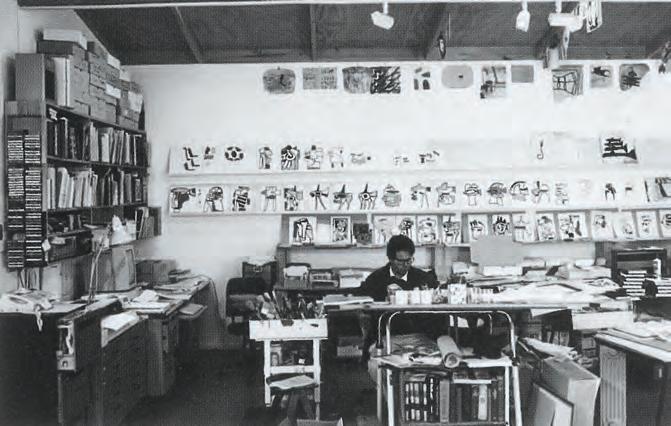
…the canvas can no longer be seen as an area in which things can be arranged.1
In his doctoral thesis Cut-Outs Killeen, renowned art historian Francis Pound was granted access to Richard Killeen’s notebooks. 2 Examining these in concert with 21 years of artwork allowed Pound to explore not only the function and development of Killeen’s practice, but how this aligned to the artist’s intentions, and to track how these morphed as he moved from painting to, in 1978, developing the novel freely placed aluminium cut-out works we associate with the name Killeen today — of which Still Life with James Joyce (1995) is a prime example.
As Pound uncovers, before he could get past the canvas, Killeen spent years experimenting with placement, pondering how to relate things together and how to relate them to the ground. 3 In a chapter entitled The end of chance, the counterfeiting of chance, and the cutouts to come, Pound quotes one of Killeen’s notebooks ad nauseam to reveal Killeen’s fixation on the relationship between the canvas and his placement of ‘objects’ upon it as he works towards eventually “not having a background at all” and allowing someone else to dictate the positioning of elements on a wall.4 The fact that the epigraph of this essay – a quote from one of his notebooks – was penned in 1970, eight years before he arrived at the cut-outs, hints at the exploratory nature of Killeen’s practice and the intensity of his desire to escape ‘the frame’. Although Pound’s thesis is specific in its positioning of every work as leading up to the cut-outs, this desire manifests clearly in each series of work, echoed by Killeen’s written instructions to himself.

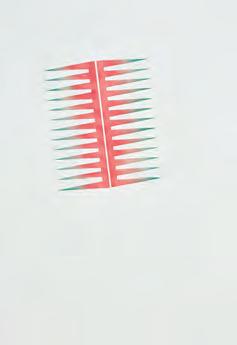
Clean shapes on canvas separate from the ground if not attached to the edge… Each remains what it is.5
From 1973—1974, Killeen’s practice was dominated by the Comb works, a series of highly stylised, sharptoothed, single and double-sided combs painted on a white background, always at an angle, never centred on the canvas as a way of refusing the containment it offered. This work, Green Tipped Comb (1974), was a later comb, made after Killeen had begun experimenting with cardboard stencils, drybrushing over them to create colours that appear soft and hazy, with what Killeen described as a look of “distances and secondhandedness.”6
From the Combs, Killeen moved to grids, similarly floating their geometric forms on a white background, perpendicular to the edges of the canvas, eventually coming to –somewhat inexplicably – place bugs within his painted nets. By 1977, he had dispelled with the nets entirely; insects, plants, animals, birds and dish of all kinds had taken over completely, aluminium and paper grounds teeming with life, and it is from this period that lot 18, Untitled (1977), comes – perhaps the most clear-cut precursor to the cut-outs, the first of which he would make the following year.7 In this work, pure flat silhouettes are stencilled in matte enamel, appearing sticker-like atop the slick aluminium surface, their dark forms stark against the silvery ground, its shine rendering it ethereal, almost invisible, teetering close to a complete loss of background.
By the late 1980s, Killeen had been making cut-outs for almost a decade when he acquired an Apple computer and begun using applications such as MacPaint and MacDraw to generate images for his work, using these as a base to create complex layered combinations. The work Still Life with James Joyce (1995) is one of several works with this title, each featuring computergenerated images of traditional still-life objects turned pattern-like through overlapping: forks formed into a fan, another with a handle meandering into a spiral atop a checkerboard, a giant blue bottle floating beside a chair, a painterly bottle. Joyce’s iconic wire-framed spectacles appear more than once, arms crossed against various backdrops, their simplified form appearing almost like punctuation.
There is some irony in the fact that Killeen’s cut-outs –a method borne from a desire to alienate his art from his hand – should become so instantly recognisable as Killeen’s. While perhaps not all immediately recognisable as such, this trio of works showcases three distinct eras in his adventurous practice, all crucial in the development of the iconic floating fragments now synonymous with the name Killeen.
▲ 1 Richard Killeen, Green Notebook, 99, quoted in Francis Pound, “Cut-Outs Killeen,” (PhD Thesis, University of Auckland, 1991), 115.
▲
2 Charmingly, Pound muses on whether he has transformed the notebooks from “private aids into the full publicity of the oeuvre” by paginating them and publishing so many excerpts within his thesis. Pound, 7.
▲ 3 Ibid., 123-124
▲ 4 Ibid., 113.
▲
5 Killeen, Blue Notebook, 91, quoted in Pound, 197.
▲ 6 Ibid., 140, quoted in Pound, 199.
▲ 7 Pound, 262.

42 Richard Killeen, Still Life with James Joyce 1995
acr ylic on aluminium, 27 pieces signed Killeen, dated 1995 and inscribed Still life with James Joyce in brushpoint lower edge (one panel) 1430 × 1600mm (variable)
est $50,000 — $60,000
What do you see in Harbour at Night (1999)? Is it a fairytale, a dream, a nightmare? Séraphine Pick is one of the most significant local painters to emerge from the 1990s, and her celebrated early paintings are recognisable for their ethereal figures and elusive symbolism, usually set within ambiguous, moonlit dreamscapes. Spectral girls dressed in white, naked human bodies with animal heads, faceless figures embracing, spindly hospital beds placed outside in the blue night, a pile of bodies we hope are sleeping, paint dripping down the canvas like tears. In Harbour at Night, distinct elements are placed in tableau within a sparse, inky landscape, as though multiple parts of a story are being presented all at once, time no longer linear but something swirling and unstuck, divorced from place, unanchored and unsettling.
Did You Hear Something (1999) shows Pick working in a more provisional style, the canvas a patchwork of colours worked over in chalky white; folkloric figures and forms rendered mostly in spidery black and brown, like a sketchbook laid out flat and pasted together to form a kind of hare-brained narrative. Describing Pick’s “white works” from the mid to late 1990s, curator Felicity Milburn highlights the “masking nature of the gauzy paint surface,” stating: “The alternatively revealing and veiling layers in Pick’s work act as a metaphor for the seemingly random process of human


recall, which allows some memories to remain clear and prominent while others simply fade away.”1 As the title suggests, Did You Hear Something slips in and out of earshot as line-drawn figures go unfinished, blank faces turn to meet our gaze and mazes of geometric forms seem to sprout in clusters across the canvas, sometimes appearing like a series of interlocking runes begging to be deciphered, other times clustering into a lattice of rectangles recalling the suitcases, shoe boxes and paperbag-clad faces of Pick’s personal iconography.
Painted just one year later at the dawn of the new millennium, Camper (2000) exemplifies the abrupt stylistic shifts Pick had made constantly throughout her career. With its vivid colour and suggestive, intricate details, Camper recalls the fantastical, often violent narrative works of Hieronymous Bosch and the haunting, enigmatic painted worlds of British Mexican surrealist painter Leonora Carrington. 2 Quite unlike
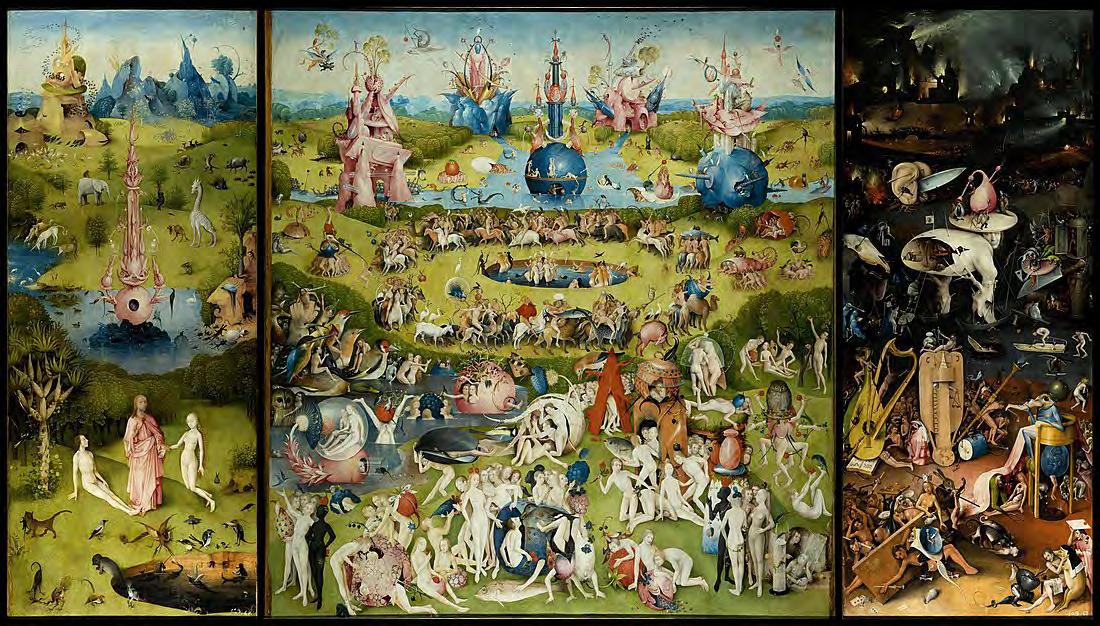
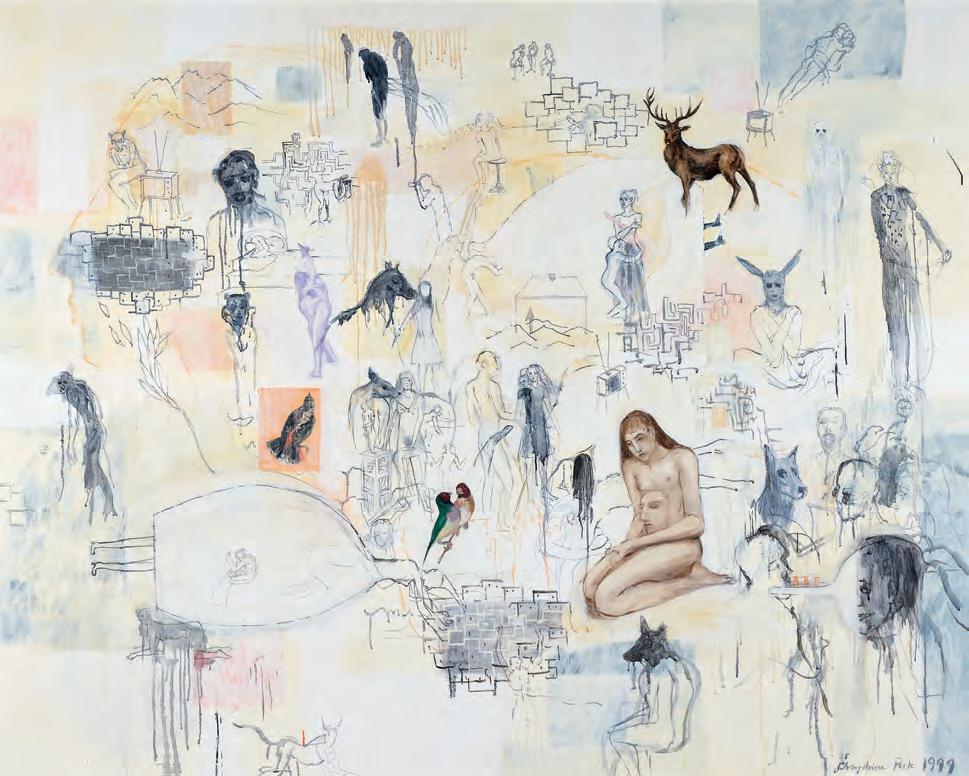
43 Séraphine Pick, Did You Hear Something 1999 oil on canvas
signed Séraphine Pick and dated 1999 in brushpoint lower right 1590 × 1980mm est $60,000 — $90,000
Private collection, Wellington.
the shallow stage of Harbour at Night or collaged fragments of Did You Hear
Something, Camper shows a detailed foreground, midground and background with coastal mountains stretching back into the distance, breadcrumbs of story dropped along the pathway – a white apartment block standing all alone in the middle of nowhere, a red-robed figure lying in the grass, a satellite dish twirling atop a small dwelling. In the fore, two maquette-like figures are engaged in some kind of altercation, the fully realised figure on the right holding her stiff arms akimbo as though preparing to deliver a punch to the faceless, trouserless one on the left.
▲ 1 Felicity Milburn, Séraphine Pick: Scratching Skin (Christchurch: McDougall Contemporary Art Annex, 1998), 10.
▲ 2 Pick’s monumental Riki and Ruru – painted in the same year, for the exhibition Parihaka: The Art of Passive Resistance – makes clear reference to these artists, along with the Mexican muralists.
▲ 3 Felicity Milburn, “Séraphine Pick: Assumed Identities,” Bulletin 157, June 10, 2010, https://christchurchartgallery. org.nz/bulletin/157/seraphinepick-assumed-identities
Much like the work of Carrington and other surrealists, Pick’s paintings from this period are interested in making visual the processes of imagination and memory. Sometimes, as with Camper, these processes may take the form of a linear – if cryptic – journey, culminating in an ambiguous exchange with an anonymous entity. Other times, there is no progress to be tracked, only a collection of fragments, half-remembered gestures, furniture, shapes and interactions that somehow amount to something more intense, more real and haunting than each constituent part might suggest. As Milburn writes, discussions of Pick’s work amongst her fans often “reveal a sense of personal connection and involvement with the figures and situations she brings to life on the canvas.”3 Despite their strangeness – or perhaps because of it – Pick’s paintings beckon us closer, holding us there as we try not only to make sense of them, but to understand why they feel so familiar, as though we’ve dreamed them before.
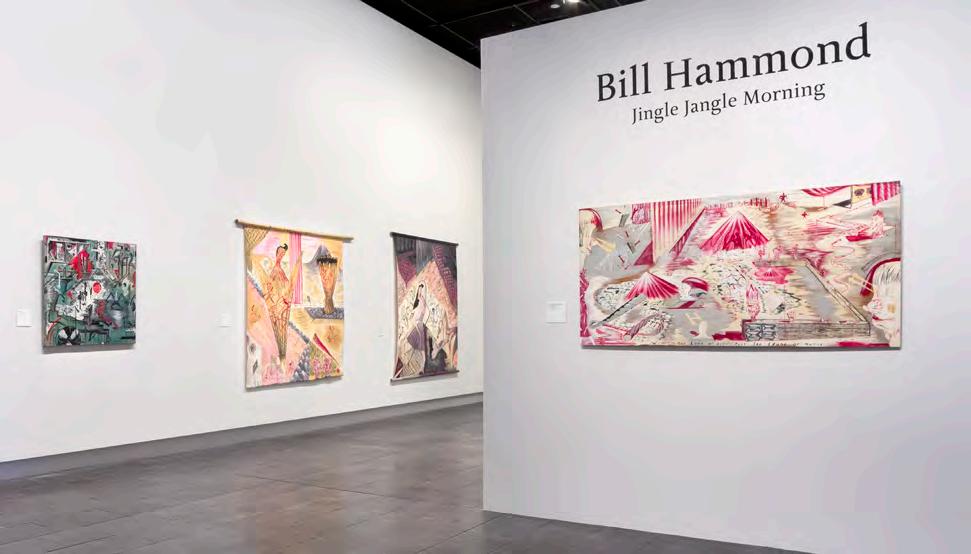
Before he became obsessed by birds and began painting the signature bird-people that would establish him as a market favourite, Bill Hammond was a melomaniac, a drummer with a paintbrush making punky, fleshy, volatile, dystopian, gritty, repulsive, rock’n’roll paintings.
If that seems like a lot of adjectives, it’s because Hammond’s early work is hyperactive, angular, filled with multiple, jarring perspectives, figures morphing into land masses, the alps sprawling across tabletops, snow-capped mountains sprouting veins, theatrical curtains falling from the sky to divide
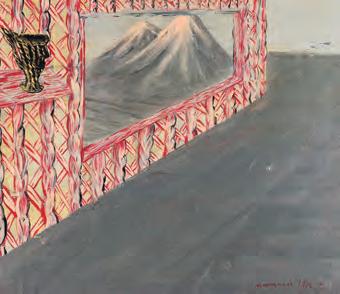
acidic plains, splicing space that could be interior, exterior or both. In untitled (1983), an unusually sparse painting, a coarsely painted grey space that might be an empty room or a bare strip of land like a carpark is bordered by a wall papered with a red, braided pattern, possibly recalling the tukutuku panels that often line the walls of wharenui, or the loud motifs of 1950s fabric, inspired by his grandmother’s and aunty’s dresses in an old family photo.1 A single wood-grained shelf protrudes from this textured wall, upon which sits a strange, ropey urn that almost resembles a face. Beyond the wide window, two brooding grey mountains can be seen.
As curator Justin Paton points out, Hammond’s interiors came at a time when “the domestic interior had begun to trump landscape as a subject for local painters”; a necessary response to a canon dictated for so long by colonial depictions of the land. 2 In untitled (1983), the interior is depicted much like a stage, viewed from the wings, the edge of the floor pitched slightly too high, lurching upwards like a horizon line, unsettling our understanding of space, a slow build towards what Paton describes as an “architectural panic attack.”3
Painted just two years later, All Shook Up (1985) doesn’t just unsettle our perspective — it viscerally wrenches us from kitchen stove to mountaintop, careening around the canvas without pause, interior spaces seemingly fenced by tiny mountains but unable to contain the balloon of a monstrous body, Elvis rising from the kitchen floor, his tiny crotch gyrating against a
44 Bill Hammond, All Shook Up 1985
acr ylic on canvas; wooden rod signed W. D. Hammond and dated 1985 in brushpoint lower edge; inscribed ALL SHOOK UP in brushpoint upper edge 1700 × 1760mm est $175,000 — $275,000
Formica chair, his yellow torso shaped like an inverted pyramid, a blood-streaked volcano neck sprouting from the base like something from a David Cronenberg film, only recognisable as The King due to that unmistakable quiff of greasy black hair – and perhaps due to the title, shared with one of his most famous songs:
Her lips are like a volcano that’s hot I’m proud to say that she’s my buttercup I’m in love, I’m all shook up Grotesque, lathering musicians of all kinds have appeared regularly in Hammond’s work over the years, such as the exhibition titled Lines from Songs, one of his first showings at Brooke Gifford Gallery in central Christchurch, which included works such as Heading for the Last Roundup and Radio On, both now held in the collection of Christchurch Art Gallery Te Puna o Waiwhetū.4
exhibitions
Bill Hammond: Jingle Jangle Morning, Christchurch Art Gallery Te Puna o Waiwhetū, Christchurch, 20 July–22 October 2007; Loft Gallery, Motueka, September 1987; Hammond/Webster, Waikato Museum of Art, Hamilton, 1985.
literature
Jennifer Hay, Laurence Aberhart, Chris Knox and Ron Brownson, Bill Hammond: Jingle Jangle Morning, (Christchurch: Christchurch Art Gallery Te Puna o Waiwhetū, 2007), 64–65.
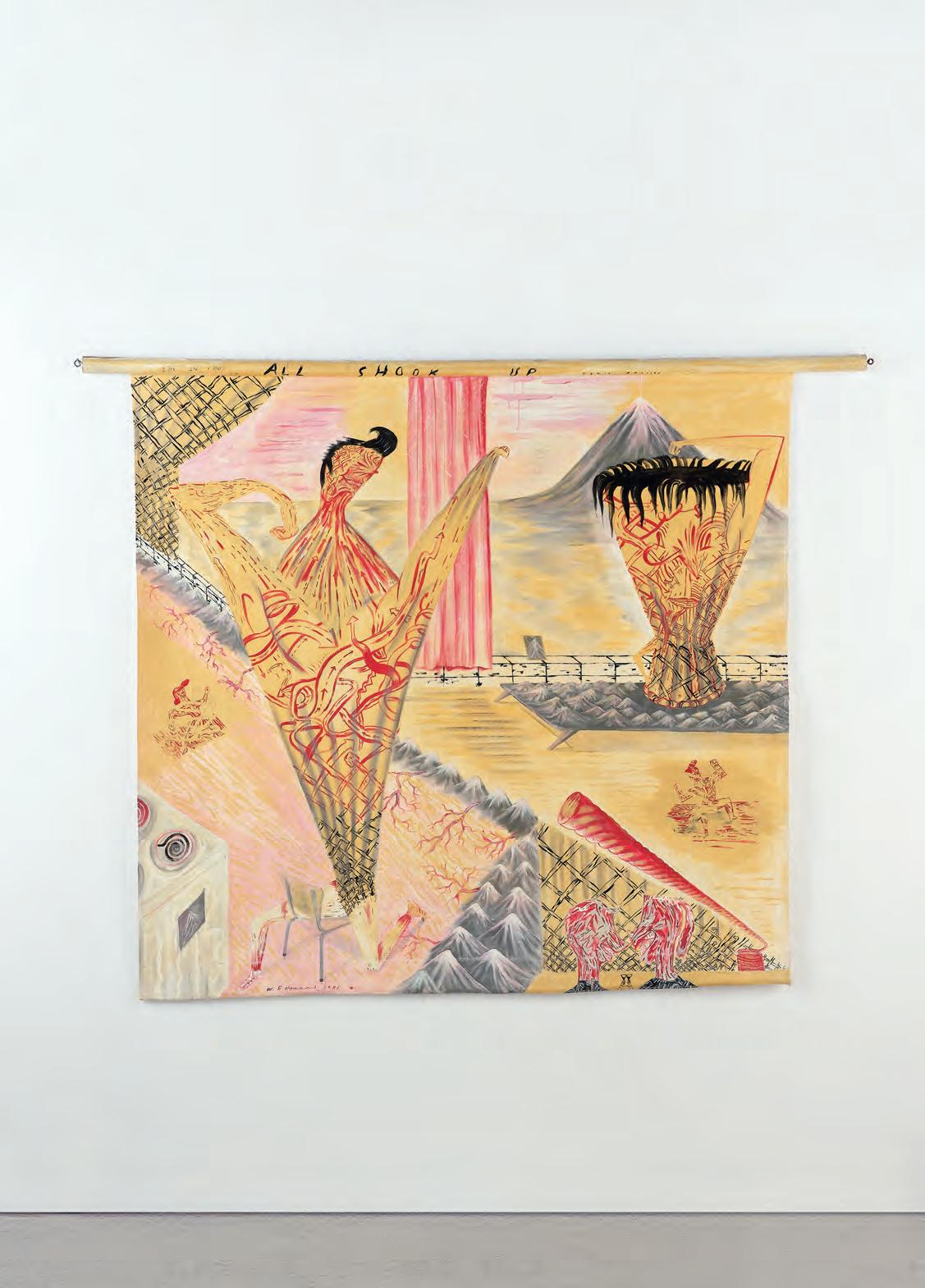
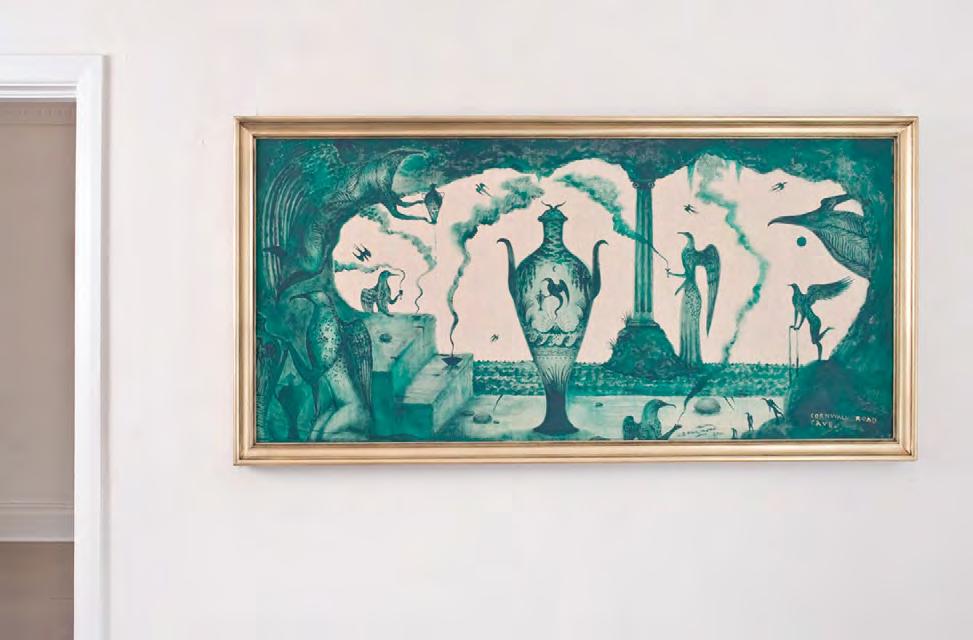
The third significant painting in this grouping was made over two decades later, once Hammond was well into his birdland years. The titular work from his 2011 exhibition at Wellington’s McLeavey Gallery, Cornwall Road Cave (2011), is an aqueous teal-green scene of graceful bird-people gathered inside the mouth of a large cave, many of them holding vessels from which emerald smoke rises in sinuous plumes. The title Cornwall Road Cave references an actual road in Lyttleton, one that intersects with Canterbury Street, where Hammond’s long-time studio was located. Although there is no written record of a cave of this name, the hills of Lyttleton are pocked with caves such as Urumau, a sacred cave and urupa just a short hike from Hammond’s studio.
In his poetic essay “In Search of the Birdman” (printed alongside writing from numerous other creatives in the book Across the Evening Sky, published after Hammond’s death in 2021), Ngāi Tahu writer Nic Low describes cycling in search of the caves that appear across many of Hammond’s paintings, visiting Horomaka Island, Te Ana a Hineraki, Moncks Cave and Evans Pass. From here, Low describes what he sees, what Hammond saw, “This is the view from Hammond’s caves: Horomaka as smoking volcano, as stands of bush against luminous space. As a place peopled by birds.”5
▲ 4 Peter Vangioni, “Doctor Jazz Stomp and the Webb Lane Sound,” Christchurch Art Gallery Te Puna o Waiwhetū Bulletin. 196, published May 28 2019. https://christchurchartgallery.org.nz/bulletin/196/ doctor-jazz-stomp-and-the-webb-lane-sound
▲ 5 Nic Low, “Bill Hammond: In search of the birdman” on The Spinoff, published December 7 2021, https://thespinoff.co.nz/books/07-12-2021/ bill-hammond-in-search-of-the-birdman
Low’s text reflects the Aotearoa Hammond conjures in his birdland paintings, which he began painting after visiting the sub-Antarctic Auckland Islands south of Bluff, a trip that inspired him to imagine a prehistoric land, predator free and populated only by birds. In his Cornwall Road paintings, Hammond visualises his anthropomorphic birds in a renovated cave, the ceiling reinforced by an ionic column, with terraced seating and a polished floor upon which is placed a large, Greek-style urn decorated with images of nature: clouds, leaves, grasses and waves, as well as a ghostly bird-person holding another urn above a maunga, suggesting that these anthropomorphic figures have formed their own culture not dissimilar to that of ancient human civilisations. While this image is beautiful, even utopian, one cannot help but wonder about these birds revealing such human proclivities as the desire to build, to engage in rituals, to make art. So far, all peaceful activities, but ones that mirror the so-called progress of human civilisation, a march that eventually reaches the scenes Hammond was painting in the 1980s, of madness, excess, paranoia and decay.

45 Bill Hammond, Cornwall Road Cave 2011 oil on linen signed W. D. Hammond, dated 2011 and inscribed CORNWALL ROAD CAVE in brushpoint lower right 690 × 1490mm est $330,000 — $530,000
provenance Private collection, Wellington.
exhibitions Cornwall Road Cave, McLeavey Gallery, Wellington, 16 November –10 December 2011.
literature
Peter Vangioni with Tony de Lautour, Rachael King, Nic Low, Paul Scofield and Ariana Tikao, Bill Hammond: Across the Evening Sky, (Christchurch: Christchurch Art Gallery Te Puna o Waiwhetū, 2021), 118–121.

46 Liz Maw, Salome 2017 oil on board 2085 × 1050mm
est $65,000 — $95,000
provenance
Private collection, Wellington. Acquired from Ivan Anthony Gallery, Auckland, 2017.
exhibitions
Andrew McLeod and Liz Maw: New Paintings, Ivan Anthony Gallery, Auckland, 22 July–16 August 2017.
Liz Maw occupies an unusual space in the contemporary canon. She graduated from Elam School of Fine Arts in 2002, is represented in both Tāmaki Makaurau and Pōneke, exhibits regularly, and has been widely collected by individuals and institutions for decades, yet there is little critical discourse written about her work. Reflecting on a period when she worked with Maw, curating her work into the 2006 exhibition Mystic Truths at Auckland Art Gallery Toi o Tāmaki, Natasha Conland describes how her paintings at this time “made their way almost surreptitiously into the hands of private collectors with very little public exposure.”1 In 2024 this hasn’t changed, with Maw’s singular, prized paintings still circulating discreetly like, impeccably detailed little secrets.
Except that Maw’s paintings often aren’t little at all, and Salome (2017) certainly isn’t. At over two metres high and a metre across, Salome is larger than life in her tight jeans and goldflecked shirt, the fabric clinging to her torso, revealing the shape of her taut abdominal muscles, and pert nipples. Like many of Maw’s works, there is something erotic in Salome, not just in her form rendered with such smooth, careful brushstrokes, and the light catching on hidden droplets falling across her shoulders, but our position: we are viewing her as she gazes transfixed on something else, her posture (neck tilted, jaw slack) echoing so many bodies standing in front of artworks. Looking at Salome, we become voyeurs, aware that we are looking at someone who is entirely unaware she is being watched, the intimacy, discomfort or eroticism of this gaze elevated by Maw’s sensual, almost photorealistic style.
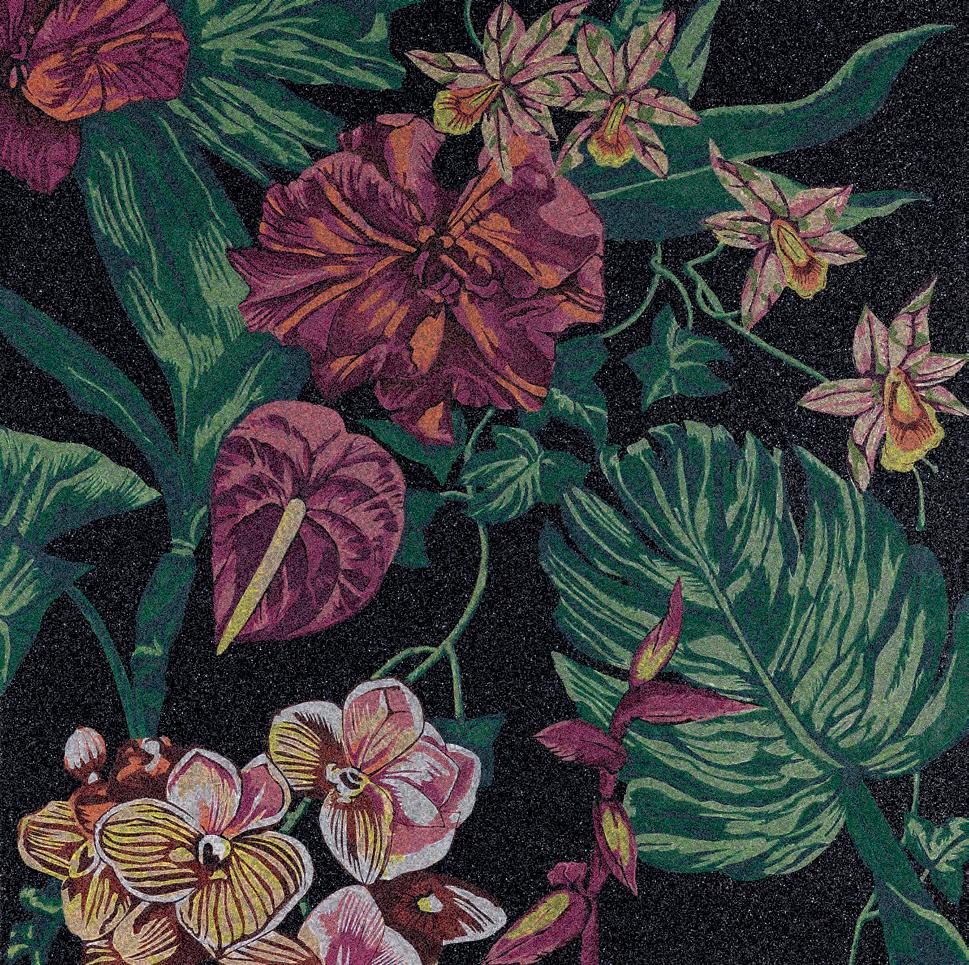
47 Reuben Paterson, Something is Going to Happen to Me Today 2018 glitter and acrylic on canvas signed Reuben Paterson and dated 2018 in brushpoint verso 1200 × 1200mm est $17,000 — $24,000
collection, Wellington. Acquired from Page Galleries, Wellington.
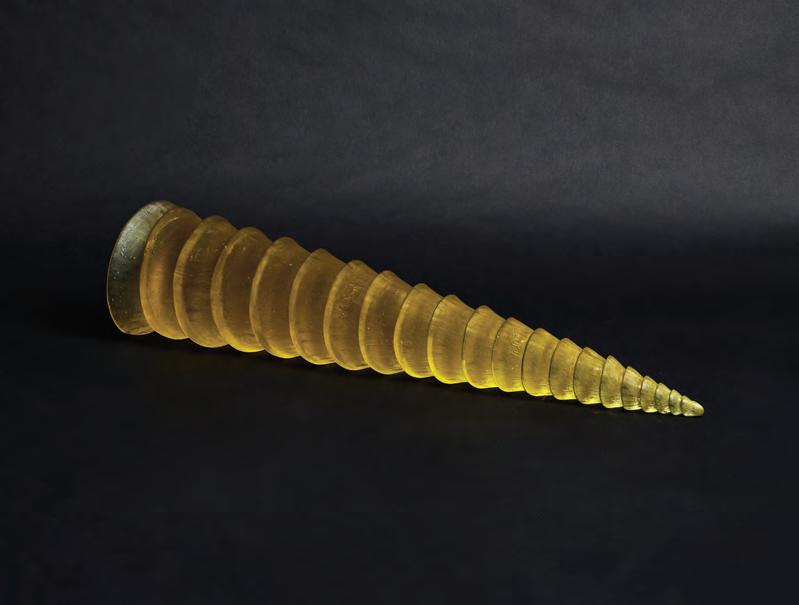
48 Ann Robinson, Crustacean 2004 cast glass
signed A Robinson and dated 2004 with incision lower edge 160 × 720 × 160mm (widest points)
est $25,000 — $35,000
provenance
Private collection, Wellington. Acquired from FHE Galleries, Auckland.
49 Ann Robinson, untitled 2004
cast glass, 1/1
signed A Robinson and dated 2004 1/1 with incision on base
640 × 160 × 160mm (widest points)
est $25,000 — $35,000
provenance
Private collection, Wellington. Acquired from FHE Galleries, Auckland.

In her fourth year of study at Whitecliffe College of Arts and Design, Christina Pataialii introduced house paint into her work. As her father was a house painter, it was a medium with which Pataialii had an intimate familiarity, and part of her attraction was certainly to its unique materiality, being notably opaque, and tending to flatten forms. But in Band on the Run, Pataialii unites house paint with artist’s acrylic, ‘low’ art with ‘high’. This encourages a tension or discussion between the two mediums, a negotiation that Pataialii is not in full control of. Noting the tensions and oppositions of her biracial identity (she is of Sāmoan and Pākehā descent) Pataialii does not shy away from embracing them in her work. Pataialii has described house paint as “honest”, and another aspect of the medium’s allure for her is its normally utilitarian function, and the idea of bringing this into the gallery. In Morning Light she takes this idea further by using a drop cloth as her canvas. “I think it is interesting and destabilising to use house paint on drop cloth, wrap it around artist canvas and then put it in a gallery space and say, ‘This is painting’,” she explains. “I’m not taking the piss, I’m asking to be taken seriously.”1 In a sense, Pataialii does the same thing with her colour palette. For example, in her 2019 exhibition at Tim Melville Gallery titled On the Lam, the pastel hues were influenced by the colours of state houses in the central and western Auckland suburbs where Pataialii spent her childhood. These colours are notable in this work, Band on the Run, and a tension remains: in the contrasting colours; in the intermediary status of dusk; and in the push and pull between representation and abstraction.
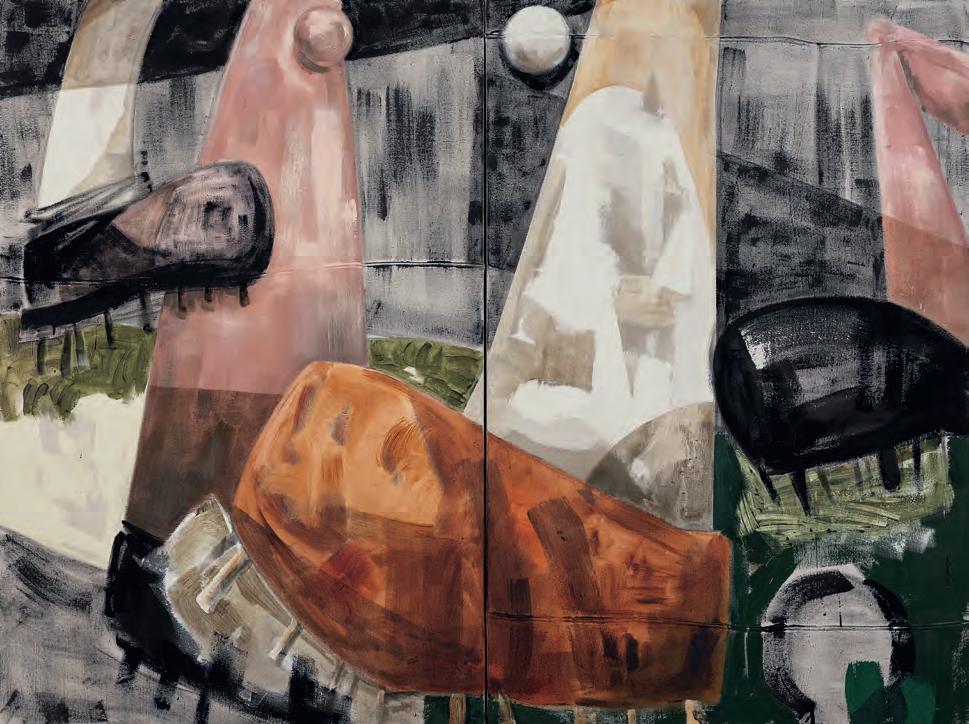
50 Christina Pataialii, Band on the Run 2019
acr ylic and housepaint on canvas drop cloth 1530 × 2020mm (overall)
est $9,500 — $13,500
provenance
Private collection, Wellington. Acquired from McLeavey Gallery, Wellington, 2019.
exhibitions
A Place Apart, City Gallery Wellington, 28 May–1 November 2020.

51 Séraphine Pick, Harbour at Night 1999 oil on canvas signed S. Pick and dated 1999 in brushpoint lower right 405 × 500mm est $10,000 — $16,000
provenance
Private collection, Wellington.
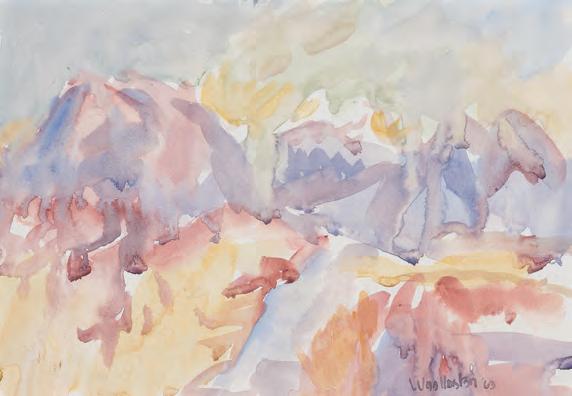
52 Toss Woollaston, Taratama — Hohonu and Turiwhate (The Road To Kumara) 1963 watercolour on paper signed Woollaston and dated '63 in brushpoint lower right 255 × 365mm est $5,000 — $8,000
provenance
Private collection, Wellington. Acquired from Page Galleries, Wellington.
53 Kushana Bush, To Catch a Fish 2019 watercolour and gouache on paper 196 × 275mm
est $4,000 — $6,000
provenance
Private collection, Wellington. Acquired from Ivan
Auckland, 2019.

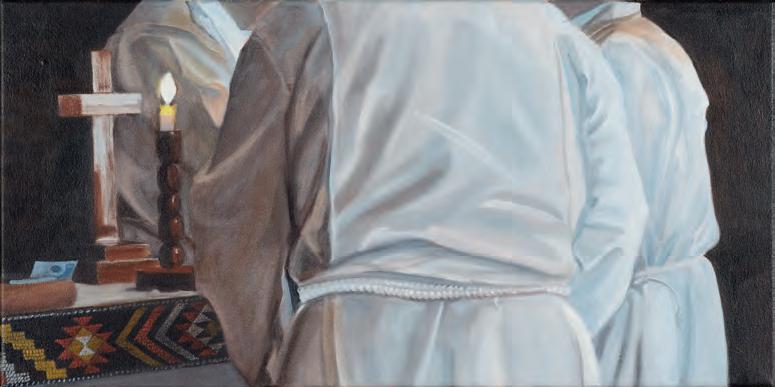
54 Hiria Anderson-Mita, The Three Ministers 2017 oil on canvas signed Hiria, dated 2017 and inscribed The Three Ministers in graphite verso 305 × 610mm
est $4,000 — $6,000
provenance
Private collection, Wellington. Acquired from Tim Melville Gallery, Auckland, 2017.
exhibitions A Painter on Turongo Street, Tim Melville Gallery, Auckland, 3–28 October 2017.

55 Terry Stringer, Sleeping Muse 2008
bronze, artist's proof signed TERRY STRINGER and dated 2008 with incision verso 165 × 170 × 150mm (widest points)
est $3,500 — $5,000
provenance
Private collection, Wellington.

56 Terry Stringer, Elevation 1999
bronze signed TERRY STRINGER and dated 1999 with incision lower edge; inscribed METROPOLIS with incision verso 120 × 120 × 25mm (widest points)
est $2,500 — $3,500
provenance
Private collection, Wellington.

57 Terry Stringer, Men to Me 2018 bronze, 8/20 signed TERRY STRINGER, dated 2010 and inscribed MEN TO ME with incision on base 130 × 55 × 50mm (widest points)
est $2,500 — $3,500
provenance

58 Julian Hooper, untitled 2018 acr ylic on canvas signed Julian Hooper and dated 2018 in graphite verso 355 × 250mm
est $2,000 — $4,000
provenance Private collection, Wellington.
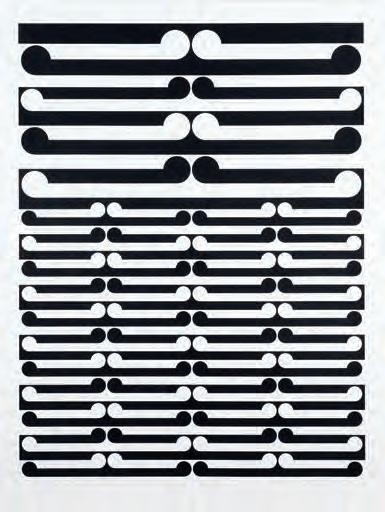
59 Gordon Walters, Genealogy III 1971. printed 2020 screenprint on paper, edition of 100 indented with Walters Estate chop mark 1055 × 805mm
est $5,000 — $7,000
provenance
Private collection, Wellington. Acquired from Starkwhite Gallery, Auckland, 2020.
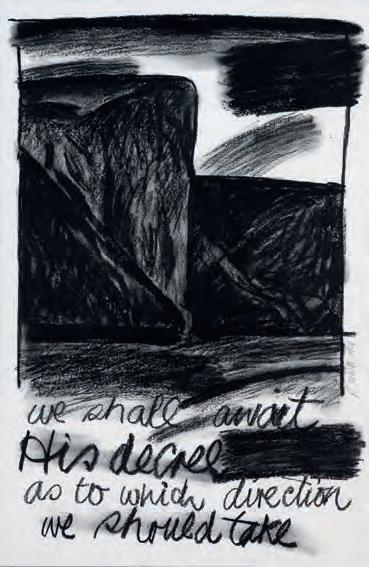
60 Robin White, untitled (from the Black Standard at Victory Beach series) 1981 charcoal on paper signed R. White and dated 1981 in graphite right edge 390 × 245mm
est $4,000 — $6,000
provenance
Private collection, Wellington. Acquired from McLeavey Gallery, Wellington.

61 Brent Harris, Peak 2017 oil on board
signed B Harris, dated 2017 and inscribed Peak in ink verso 230 × 130mm
est $4,000 — $8,000
provenance
Private collection, Wellington. Acquired from Robert Heald Gallery, Wellington.

62 André Hemer, An Image Cast By the Sun #12 2019
acr ylic and pigment on canvas signed André Hemer, dated 2019 and inscribed An Image Cast by the Sun #12 in graphite verso 380 × 270mm
est $3,000 — $5,000
provenance
Private collection, Wellington. Acquired from Yavuz Gallery, Singapore, 2019.
exhibitions
Images Cast by the Sun, Yavuz Gallery, Singapore, 22 November–22 December 2019.

63 Brent Harris, The Untimely (No.7) 1998 colour woodcut on Japanese paper, 13/20
signed BH, dated 98 and inscribed 'The Untimely' (No. 7) in graphite lower edge
600 × 450mm
est $5,500 — $10,000
provenance
Private collection, Wellington. Acquired from Robert Heald Gallery, Wellington, 2018.
exhibitions
Another from the edition exhibited in Brent Harris: Surrender and Catch, TarraWarra Museum of Art, Tarrawarra, 2 December 2023–11 March 2024; Brent Harris: Surrender and Catch, Art Gallery of South Australia, Adelaide, 6 July–20 October 2024.
literature
Another from the edition featured in Maria Zagala, Brent Harris: Surrender and Catch (Adelaide: Art Gallery of South Australia, 2023), 60.
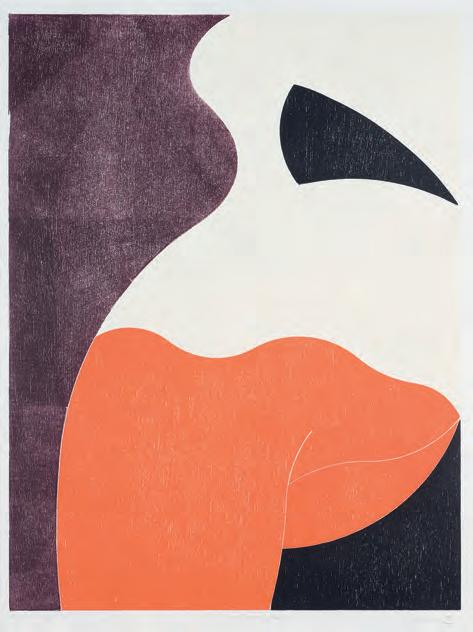
64 Brent Harris, The Untimely (No.3) 1998 colour woodcut on Japanese paper, 13/20
signed BH, dated 98 and inscribed 'The Untimely' (No. 3) in graphite lower edge
600 × 450mm
est $5,500 — $10,000
provenance
Private collection, Wellington. Acquired from Robert Heald Gallery, Wellington, 2018.
exhibitions
Another from the edition exhibited in Brent Harris: Surrender and Catch, TarraWarra Museum of Art, Tarrawarra, 2 December 2023–11 March 2024; Brent Harris: Surrender and Catch, Art Gallery of South Australia, Adelaide, 6 July–20 October 2024.
literature
Another from the edition featured in Maria Zagala, Brent Harris: Surrender and Catch (Adelaide: Art Gallery of South Australia, 2023), 60.
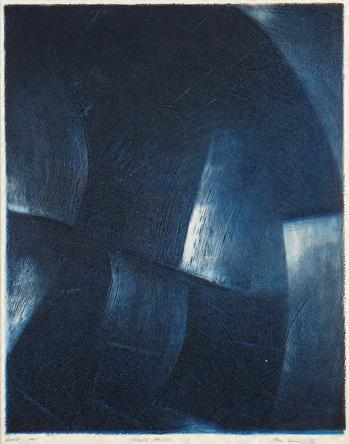
65 John Drawbridge, French Pacific c1966
aquatint on paper, artist's proof signed John Drawbridge and inscribed French Pacific in graphite lower edge
510 × 400mm
est $3,500 — $5,500
provenance
Private collection, Wellington. Acquired from Fe29 Gallery, Dunedin.
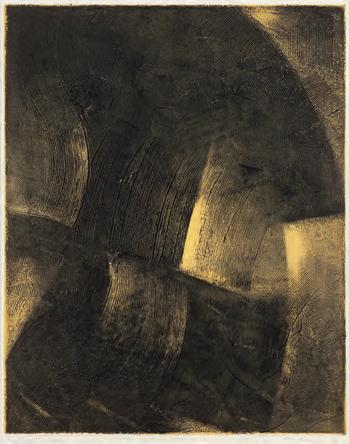
66 John Drawbridge, Trial State of French Pacific 1966
aquatint on paper, artist's proof signed John Drawbridge, dated 1966 and inscribed Trial State of French Pacific in graphite lower edge
510 × 400mm
est $3,500 — $5,500
provenance
Private collection, Wellington. Acquired from Fe29 Gallery, Dunedin.
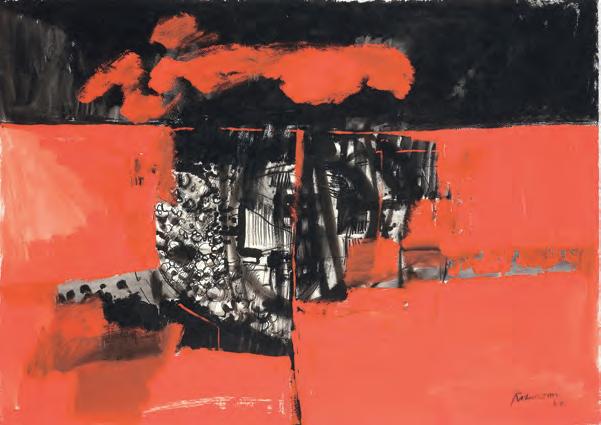
67 Robert Ellis, untitled 1968 acrylic, charcoal and ink on paper signed Robert Ellis and dated '68 in brushpoint lower right
490 × 690mm
est $5,500 — $7,500
provenance
Private collection, Wellington.
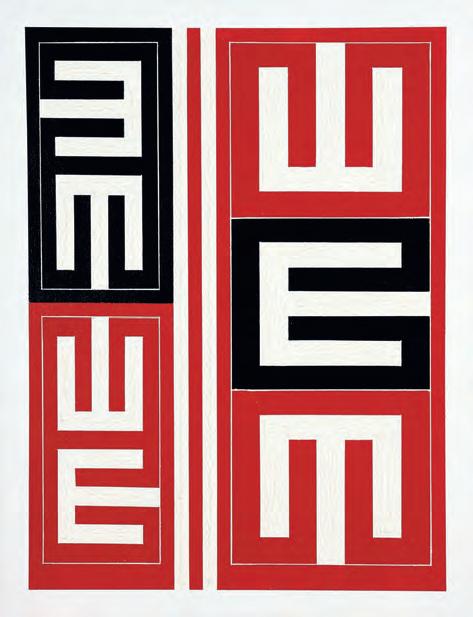
68 Darryn George, Tribute – G Bell 2007 oil on canvas
signed Darryn George, dated 2007 and inscribed Tribute – G Bell in ink verso
650 × 500mm
est $4,500 — $7,500
provenance
Private collection, Wellington.
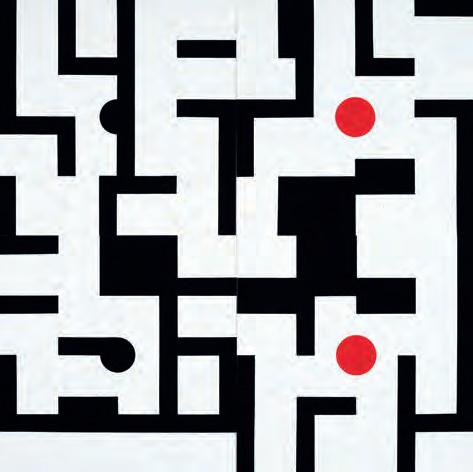
69 Simon Morris, Puzzling Manoeuvres 2003 acr ylic on alumnium signed Simon Morris, dated 1993 and inscribed Puzzling Manoeuvres in ink verso
600 × 600mm (overall)
est $4,000 — $6,000
provenance
Private collection, Wellington. Acquired from Bartley Nees Gallery, Wellington, c2002.
The terms and conditions of sale listed here contain the policies of Webb’s (Webb Fine Art). They are the terms on which Webb’s (Webb Fine Art) and the Seller contract with the Buyer. They may be amended by printed Saleroom Notices or oral announcements made before and during the sale. By bidding at auction you agree to be bound by these terms.
3.3. Buyers Responsibility
All property is sold “as is” without representation or warranty of any kind by Webb’s or the Seller. Buyers are responsible for satisfying themselves concerning the condition of the property and the matters referred to in the catalogue by requesting a condition report.
No lot to be rejected if, subsequent to the sale, it has been immersed in liquid or treated by any other process unless the Auctioneer’s permission to subject the lot to such immersion or treatment has first been obtained in writing.
4.1. Refusal of Admission
1. B ackground to the Terms used in these Conditions
The conditions that are listed below contain terms that are used regularly and may need explanation. They are as follows:
“the Buyer” means the person with the highest bid accepted by the Auctioneer.
“the Lot” means any item depicted within the sale for auction and in particular the item or items described against any lot number in the catalogue.
“the Hammer price” means the amount of the highest bid accepted by the auctioneer in relation to a lot.
“the Buyer’s Premium” means the charge payable by the Buyer to the auction house as a percentage of the hammer price.
“the Reserve” means the lowest amount at which Webb’s has agreed with the Seller that the lot can be sold.
“Forgery” means an item constituting an imitation originally conceived and executed as a whole, with a fraudulent intention to deceive as to authorship, origin, age, period, culture or source, where the correct description as to such matters is not reflected by the description in the catalogue. Accordingly, no lot shall be capable of being a forgery by reason of any damage or restoration work of any kind (Including re-painting).
“the insured value” means the amount that Webb’s in its absolute discretion from time to time shall consider the value for which a lot should be covered for insurance (whether or not insurance is arranged by Webb’s).
All values expressed in Webb’s catalogues (in any format) are in New Zealand Dollars (NZD$). All bids, “hammer price”, “reserves”, “Buyers Premium” and other expressions of value are understood by all parties to be in New Zealand Dollars (NZD$) unless otherwise specified.
2. Webb’s Auctions as Agent
Except as otherwise stated, Webb’s acts as agent for the Seller.
The contract for the sale of the property is therefore made between the Seller and the Buyer.
3. B efore the Sale
3.1. E xamination of Property
Prospective Buyers are strongly advised to examine in person any property in which they are interested before the Auction takes place. Neither Webb’s nor the Seller provides any guarantee in relation to the nature of the property apart from the Limited warranty in the paragraph below.
The property is otherwise sold “AS IS”
3.2. Catalogue and Other Descriptions
All statements by Webb’s in the catalogue entry for the property or in the condition report, or made orally or in writing elsewhere, are statements of opinion and are not to be relied upon as statements of fact. Such statements do not constitute a representation, warranty or assumption of liability by Webb’s of any kind. References in the catalogue entry to the condition report to damage or restoration are for guidance only and should be evaluated by personal inspection by the bidder or a knowledgeable representative. The absence of such a reference does not imply that an item is free from defects or restoration, nor does a reference to particular defects imply the absence of any others. Estimates of the selling price should not be relied on as a statement that this is the price at which the item will sell or its value for any other purpose. Neither Webb’s nor The Seller is responsible for any errors or omissions in the catalogue or any supplemental material.
Images are measured height by width (sight size). Illustrations are provided only as a guide and should not be relied upon as a true representation of colour or condition. Images are not shown at a standard scale. Mention is rarely made of frames (which may be provided as supplementary images on the website) which do not form part of the lot as described in the printed catalogue.
An item bought “on Extension” must be paid for in full before it will be released to the purchaser or his/her agreed expertising committee or specialist. Payments received for such items will be held “in trust” for up to 90 days or earlier, if the issue of authenticity has been resolved more quickly. Extensions must be requested before the auction.
Foreign buyers should note that all transactions are in New Zealand Dollars so there may be a small exchange rate risk. The costs associated with acquiring a good opinion or certificate will be carried by the purchaser. If the item turns out to be forged or otherwise incorrectly described, all reasonable costs will be borne by the vendor.
Webb’s reserves the right at our complete discretion to refuse admission to the auction premises or participation in any auction and to reject any bid.
4.2. Registration Before Bidding
Any prospective new buyer must complete and sign a registration form and provide photo identification before bidding. Webb’s may request bank, trade or other financial references to substantiate this registration.
4.3. Bidding as a Principal
When making a bid, a bidder is accepting personal liability to pay the purchase price including the buyer’s premium and all applicable taxes, plus all other applicable charges, unless it has been explicitly agreed in writing with Webb’s before the commencement of the sale that the bidder is acting as agent on behalf of an identified third party acceptable to Webb’s and that Webb’s will only look to the principal for payment.
4.4. International Registrations
All International clients not known to Webb’s will be required to scan or fax through an accredited form of photo identification and pay a deposit at our discretion in cleared funds into Webb’s account at least 24 hours before the commencement of the auction. Bids will not be accepted without this deposit. Webb’s also reserves the right to request any additional forms of identification prior to registering an overseas bid.
This deposit can be made using a credit card, however the balance of any purchase price in excess of $5,000 cannot be charged to this card without prior arrangement.
This deposit is redeemable against any auction purchase and will be refunded in full if no purchases are made.
4.5. A bsentee Bids
Webb’s will use reasonable efforts to execute written bids delivered to us AT LEAST 24 Hours before the sale for the convenience of those clients who are unable to attend the auction in person. If we receive identical written bids on a particular lot, and at the auction these are the highest bids on that lot, then the lot will be sold to the person whose written bid was received and accepted first. Execution of written bids is a free service undertaken subject to other commitments at the time of the sale and we do not accept liability for failing to execute a written bid or for errors or omissions which may arise. It is the bidder’s responsibility to check with Webb’s after the auction if they were successful. Unlimited or “Buy” bids will not be accepted.
4.6. Telephone Bids
Priority will be given to overseas and bidders from other regions. Please refer to the catalogue for the Telephone Bids form. Arrangements for this service must be confirmed AT LEAST 24 HOURS PRIOR to the auction commencing. Webb’s accepts no responsibility whatsoever for any errors or failure to execute bids. In telephone bidding the buyer agrees to be bound by all terms and conditions listed here and accepts that Webb’s cannot be held responsible for any miscommunications in the process. The success of telephone bidding cannot be guaranteed due to circumstances that are unforeseen. Buyers should be aware of the risk and accept the consequences should contact be unsuccessful at the time of Auction. You must advise Webb’s of the lots in question, and you will be assumed to be a buyer at the minimum price of 75% of estimate (i.e. reserve) for all such lots. Webb’s will advise Telephone Bidders who have registered at least 24 hours before the auction of any relevant changes to descriptions, withdrawals, or any other sale room notices.
4.7.
Webb’s offers an online bidding service. When bidding online the buyer agrees to be bound by all terms and conditions listed here by Webb’s. Webb’s accepts no responsibility for any errors, failure to execute bids or any other miscommunications regarding this process. It is the online bidder’s responsibility to ensure the accuracy of the relevant information regarding bids, lot numbers and contact details. Webb’s does not charge for this service.
4.8. Reserves
Unless otherwise indicated, all lots are offered subject to a reserve, which is the confidential minimum price below which the Lot will not be sold. The reserve will not exceed the low estimate printed in the catalogue. The auctioneer may open the bidding on any Lot below the reserve by placing a bid on behalf of the Seller. The auctioneer may continue to bid on behalf of seller up to the amount of the reserve, either by placing consecutive bids or by placing bids in response to other bidders.
4.9. Auctioneers Discretion
The Auctioneer has the right at his/ her absolute and sole discretion to refuse any bid, to advance the bidding according to the following indicative steps:
Increment Dollar
Range A mount
$20 $0 –$500
$50 $ 500–$1,000
$100 $1,000–$2,000
$10,000–$20,000
$20,000–$50,000
$ 50,000 – $100,000 $10,000 $100,000–$200,000 $20,000 $200,000–$500,000
$ 500,000–$1,000,000
Absentee bids must follow these increments and any bids that don’t follow the steps will be rounded up to the nearest acceptable bid.
5. After the Sale
5.1. Buyers Premium
In addition to the hammer price, the buyer agrees to pay to Webb’s the buyer’s premium. The buyer’s premium is 19.5% of the hammer price plus GST. (Goods and Services Tax) where applicable.
5.2. Payment and Passing of Title
The buyer must pay the full amount due (comprising the hammer price, buyer’s premium and any applicable taxes and GST) not later than 2 days after the auction date.
The buyer will not acquire title to the lot until Webb’s receives full payment in cleared funds, and no goods under any circumstances will be released without confirmation of cleared funds received. This applies even if the buyer wishes to send items overseas.
Payment can be made by direct transfer, cash (not exceeding NZD$5,000, if wishing to pay more than NZD$5,000 then this must be deposited directly into a Bank of New Zealand branch and bank receipt supplied) and EFTPOS (please check the daily limit). Payments can be made by debit card or credit card in person with a 2.2% merchant fee for Visa, Mastercard and Paywave, and 3.3% for American Express. Invoices that are in excess of $5,000 and where the card holder is not present, cannot be charged to a credit card without prior arrangement. Cheques are no longer accepted.
The buyer is responsible for any bank fees and charges applicable for the transfer of funds into Webb’s account.
5.3. Collection of Purchases & Insurance
Webb’s is entitled to retain items sold until all amounts due to us have been received in full in cleared funds. Subject to this, the Buyer shall collect purchased lots within 2 days from the date of the sale unless otherwise agreed in writing between Webb’s and the Buyer.
At the fall of the hammer, insurance is the responsibility of the purchaser.
5.4. Packing, Handling and Shipping
Webb’s will be able to suggest removals companies that the buyer can use but takes no responsibility whatsoever for the actions of any recommended third party. Webb’s can pack and handle goods purchased at the auction by agreement and a charge will be made for this service. All packing, shipping, insurance, postage & associated charges will be borne by the purchaser.
5.5. Permits, Licences and Certificates
Under The Protected Objects Act 1975, buyers may be required to obtain a licence for certain categories of items in a sale from the Ministry of Culture & Heritage, PO Box 5364, Wellington.
5.6. Remedies for Non-Payment
If the Buyer fails to make full payment immediately, Webb’s is entitled to exercise one or more of the following rights or remedies (in addition to asserting any other rights or remedies available under the law)
5.6.1. to charge interest at such a rate as we shall reasonably decide.
5.6.2. to hold the defaulting Buyer liable for the total amount due and to commence legal proceedings for its recovery along with interest, legal fees and costs to the fullest extent permitted under applicable law.
5.6.3. to cancel the sale.
5.6.4. to resell the property publicly or privately on such terms as we see fit.
5.6.5. to pay the Seller an amount up to the net proceeds payable in respect of the amount bid by the defaulting Buyer. In these circumstances the defaulting Buyer can have no claim upon Webb’s in the event that the item(s) are sold for an amount greater than the original invoiced amount.
5.6.6. to set off against any amounts which Webb’s may owe the Buyer in any other transactions, the outstanding amount remaining unpaid by the Buyer.
5.6.7. where several amounts are owed by the Buyer to us, in respect of different transactions, to apply any amount paid to discharge any amount owed in respect of any particular transaction, whether or not the Buyer so directs.
5.6.8. to reject at any future auction any bids made by or on behalf of the Buyer or to obtain a deposit from the Buyer prior to accepting any bids.
5.6.9. to exercise all the rights and remedies of a person holding security over any property in our possession owned by the Buyer whether by way of pledge, security interest or in any other way, to the fullest extent permitted by the law of the place where such property is located. The Buyer will be deemed to have been granted such security to us and we may retain such property as collateral security for said Buyer’s obligations to us.
5.6.10. to take such other action as Webb’s deem necessary or appropriate.
If we do sell the property under paragraph (4), then the defaulting Buyer shall be liable for payment of any deficiency between the total amount originally due to us and the price obtained upon reselling as well as for all costs, expenses, damages, legal fees and commissions and premiums of whatever kinds associated with both sales or otherwise arising from the default.
If we pay any amount to the Seller under paragraph (5) the Buyer acknowledges that Webb’s shall have all of the rights of the Seller, however arising, to pursue the Buyer for such amount.
5.7. Failure to Collect Purchases
Where purchases are not collected within 2 days from the sale date, whether or not payment has been
made, we shall be permitted to remove the property to a warehouse at the buyer’s expense, and only release the items after payment in full has been made of removal, storage handling, insurance and any other costs incurred, together with payment of all other amounts due to us.
6. E xtent of Webb’s Liability
Webb’s agrees to refund the purchase price in the circumstances of the Limited Warranty set out in paragraph 7 below. Apart from that, neither the Seller nor we, nor any of our employees or agents are responsible for the correctness of any statement of whatever kind concerning any lot, whether written or oral, nor for any other errors or omissions in description or for any faults or defects in any lots. Except as stated in paragraph 7 below, neither the Seller, ourselves, our officers, agents or employees give any representation warranty or guarantee or assume any liability of any kind in respect of any lot with regard to merchantability, fitness for a particular purpose, description, size, quality, condition, attribution, authenticity, rarity, importance, medium, provenance, exhibition history, literature or historical relevance. Except as required by local law any warranty of any kind is excluded by this paragraph.
7. Limited Warranty
Subject to the terms and conditions of this paragraph, the Seller warrants for the period of thirty days from the date of the sale that any property described in this catalogue (noting such description may be amended by any saleroom notice or announcement) which is stated without qualification to be the work of a named author or authorship is authentic and not a forgery. The term “Author” or “authorship” refers to the creator of the property or to the period, culture, source, or origin as the case may be, with which the creation of such property is identified in the catalogue.
The warranty is subject to the following:
it does not apply where a) the catalogue description or saleroom notice corresponded to the generally accepted opinion of scholars and experts at the date of the sale or fairly indicated that there was a conflict of opinions, or b) correct identification of a lot can be demonstrated only by means of a scientific process not generally accepted for use until after publication of the catalogue or a process which at the date of the publication of the catalogue was unreasonably expensive or impractical or likely to have caused damage to the property.
the benefits of the warranty are not assignable and shall apply only to the original buyer of the lot as shown on the invoice originally issued by Webb’s when the lot was sold at Auction.
the Original Buyer must have remained the owner of the lot without disposing of any interest in it to any third party.
The Buyer’s sole and exclusive remedy against the Seller in place of any other remedy which might be available, is the cancellation of the sale and the refund of the original purchase price paid
for the lot less the buyer’s premium which is non-refundable. Neither the Seller nor Webb’s will be liable for any special, incidental nor consequential damages including, without limitation, loss of profits.
The Buyer must give written notice of claim to us within thirty days of the date of the Auction. The Seller shall have the right, to require the Buyer to obtain two written opinions by recognised experts in the field, mutually acceptable to the Buyer and Webb’s to decide whether or not to cancel the sale under warranty. the Buyer must return the lot to Seller in the same condition that it was purchased.
If any part of these Conditions of Sale is found by any court to be invalid, illegal or unenforceable, that part shall be discounted, and the rest of the Conditions shall continue to be valid to the fullest extent permitted by law.
The copyright in all images, illustrations and written material produced by Webb’s relating to a lot including the contents of this catalogue, is and shall remain the property at all times of Webb’s and shall not be used by the Buyer, nor by anyone else without our prior written consent. Webb’s and the Seller make no representation or warranty that the Buyer of a property will acquire any copyright or other reproduction rights in it.
10.
These terms and conditions and any matters concerned with the foregoing fall within the exclusive jurisdiction of the courts of New Zealand, unless otherwise stated.
Webb’s publishes with each catalogue our opinion as to the estimated price range for each lot. These estimates are approximate prices only and are not intended to be definitive. They are prepared well in advance of the sale and may be subject to revision. Interested parties should contact Webb’s prior to auction for updated pre-sale estimates and starting prices.
12.
Webb’s will provide auction results, which will be available as soon as possible after the sale. Results will include buyer’s premium. These results will be posted at www.webbs.co.nz.
13.
GST is applicable on the hammer price in the case where the seller is selling property that is owned by an entity registered for GST. GST is also applicable on the hammer price in the case where the seller is not a New Zealand resident. These lots are denoted by a dagger symbol † placed next to the estimate. GST is also applicable on the buyer’s premium.
Anderson-Mita, Hiria 63 Ashken, Tanya 25
B Binney, Don 11 Bush, Kushana 22, 63
C Cabeikanacea, Tamari 22
Charteris, Chris 24, 38 Cotton, Shane 15, 16, 18
D de Lautour, Tony 14
Dibble, Paul 19
Drawbridge, John 68 Dunning, William 31
E Edgar, John 24 Ellis, Robert 68
G George, Darryn 69
H Hammond, Bill 10, 11, 16, 29, 50, 55 Harris, Brent 66, 67 Hemer, André 66 Hooper, Julian 65
Gordon 21, 65
Ans 12, 13

